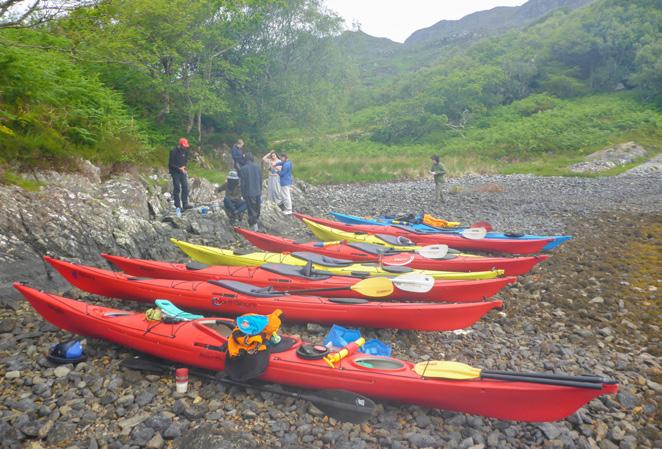CYLCHGRAWN CANŴ CYMRU JOURNAL OF CANOE WALES


CYLCHGRAWN CANŴ CYMRU JOURNAL OF CANOE WALES


Un peth y mae golygu Ceufad wedi gwneud i mi sylweddoli, yw bod gan y rhan fwyaf o badlwyr Cymru ymdeimlad
bron yn anniwall o antur. Y math sy'n cynnwys pori dros fapiau, gwasgu pecyn gwersylla i fagiau sych a dod o hyd i ffyrdd creadigol o'i bacio i mewn i‘r hatshus, ei sicrhau i ddeciau neu ei wasgu y tu ôl i gynnalyddion-cefn. Yna mynd allan i archwilio'r saith degfed gorau'r blaned.
Mae'r rhifyn hwn yn enghraifft wych o hyn, gydag alldeithiau ar yr Amason, Loch Shiel, Yr afon Hafren a Loch Sunart. Gyda padlwyr yn dod o hyd i anturiaethau gartref, dros y ffin ac ar draws yr Iwerydd. Ac ar draws y cenedlaethau hefyd gyda myfyrwyr Dewi Sant, a dau frawd neu chwaer ifanc, yn cynrychioli pen mwy ifanc y sbectrwm, yn ymgymryd â'u hanturiaethau amlddiwrnod iawn cyntaf.
I fod yn onest, mae'r mater yma wedi achosi tipyn o 'notriffobia', felly mwynhewch y rhifyn – mae gen i ambell drip i’w gynllunio!
Vicky Barlow
Golygydd

Ceufad
One thing that editing Ceufad has made me realise, is that most Welsh paddlers have an almost insatiable sense of adventure. The sort that involves poring over maps, cramming camping kit into dry bags and finding creative ways to stow it in hatches, secure it to decks or squeeze it behind backrests. Then heading out to explore the best seven-tenths of the planet.
This issue is a great example of this, with expeditions on the Amazon, Loch Shiel, River Severn and Loch Sunart. With paddlers finding adventures at home, across the border and across the Atlantic. And across the generations too, with the students of St David’s, and two young siblings, representing the more youthful end of the spectrum, undertaking their first proper multi-day paddling adventures.
To be honest, this issue has caused a bit of ‘notriphobia’, so enjoy the issue – I have some trips to plan!
Vicky Barlow Editor

ceufad@canoewales.com
Ed Ceufad @Ceufad
Ceufad yw cylchgrawn swyddogol Canŵ Cymru ac mae’n rhad ac am ddim i’w aelodau. Cynhyrchir y cynnwys gan Canŵ Cymru, ei aelodau a chyfranwyr eraill, felly nid yw’r safbwyntiau a fynegir o reidrwydd yn rhai Canŵ Cymru na golygydd y cylchgrawn. Cynhyrchir Ceufad bob chwarter yn y Gwanwyn (Mawrth), Haf (Mehefin), Hydref (Medi) a'r Gaeaf (Rhagfyr)
RHIFYN NESAF: GAEAF DYDDIAD CAU:1 TACHWEDD
I gael gwybodaeth am DANYSGRIFIADAU, HYSBYSEBION a CHYFLWYNIADAU: www.canoewales.com/ceufad ceufad@canoewales.com

Ceufad Ed Ceufad @Ceufad ceufad@canoewales.com

Ceufad is the official magazine of Canoe Wales and is free to its members. Content is produced by Canoe Wales, its members and other contributors, so the views expressed are not necessarily those of Canoe Wales or the magazine’s editor. Ceufad is produced quarterly in: Spring (March), Summer (June), Autumn (Sept) and Winter (Dec) NEXT ISSUE: WINTER DEADLINE: 1 NOVEMBER For info on SUBSCRIPTIONS, ADVERTISING and SUBMISSIONS: www.canoewales.com/ceufad ceufad@canoewales.com
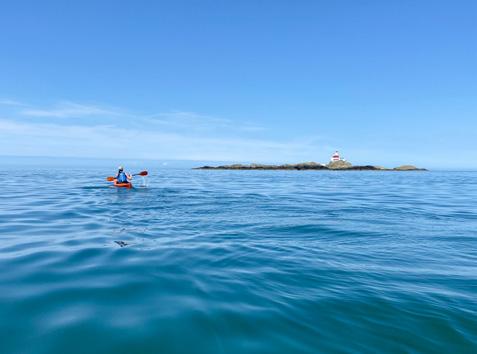

4 Newyddion Canŵ Cymru
Gwybodaeth a diweddariadau fan Canŵ Cymru
6 Canoe Wales News
Info and updates from Canoe Wales
8 Prevent Stowaways to Protect Seabirds
Help protect our amazing wildlife
12 Meet the Team
Sid Sinfield - Performance Manager
14 Transforming from the_disabled_paddler ... to she_who_dares_wins
18 Sefydliad Brenhinol Cenedlaethol y Badau
Achub (RNLI) Diwrnod Diogelwch Dŵr Cemaes
CC Amlwch yn lledaenu'r gair ar ddiogelwch chwaraeon padlo
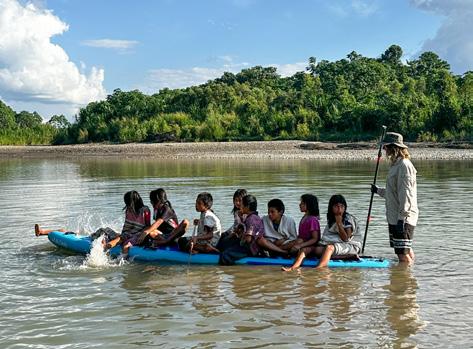

19 RNLI Water Safety Day Cemaes
Amlwch CC spread the word on paddlesport safety
20 Loch Shiel
A wilderness canoe trip
28 #ShePaddles Cymru
Summer Celebration Festival
30 Amazon Adventures
Amazon Challenge 2024
36 River Severn And Loch Sunart
Paddle expeditions with St. David’s College 18
Alistair Dickson Prif Weithredwr
TÎM GWASANAETHAU AELODAU
Andy Turton Rheolwr Hyfforddi
Val Ephraim Swyddog Gweinyddol
Suzanne Parkin Cynorthwyydd Llywodraethu ac Aelodaeth
Bonnie Armstrong Arweinydd Cyfathrebu a Marchnata
Ellen Roberts Swyddog Cyllid
Phil Stone Rheolwr Lleoedd i Badlo
Kerry Skidmore Swyddog Arweiniol Diogelu a Chydraddoldeb
Lydia Wilford Swyddog Datblygu
Emily King Arweinydd PAD/SUP
TÎM PERFFORMIAD
Sid Sinfield Rheolwr Perfformiad
Jonathan Davies Swyddog Llwybr Talent (Gogledd)
Gareth Bryant Swyddog Llwybr Talent (Gorllewin)
James Pigdon Swyddog Llwybr Talent (De)
Giacomo Leighton Talent Slalom - De
Emily Davies Talent Slalom – Gogledd
CYFARWYDDWYR
Kerry Chown Cadeirydd
Jet Moore Is-gadeirydd
Andy Booth Cyfarwyddwr Cyllid
Elsa Davies
Alun Davies
Allan Binstead
Ruth Hall
Tanya Neilson
Dave Kohn-Hollins
David Eade
CYSYLLTWCH Â CANŴ CYMRU
www.canoewales.com admin@canoewales.com 01678 521 199
Canolfan Dŵr Gwyn Genedlaethol, Frongoch, Bala, Gwynedd, LL23 7NU



Wel, dyw'r haf byth wedi dod mewn gwirionedd! Rwy'n gobeithio eich bod wedi mwynhau cyfnod ffrwythlon o haf beth bynnag ac ni wnaeth y glaw a'r gwynt rwystro'ch anturiaethau padlo gormod.
Gobeithio eich bod chi wir wedi mwynhau'r Gemau Olympaidd. Yn sicr, fe wnes i ac roeddwn i'n meddwl bod y padlo yn wych i'w wylio. Roedd hefyd yn wych i wylio llwyddiant Tîm PF yn y Slalom a Chaiac Croes. Mae'r Gemau Olympaidd yn amlwg mewn cyfnod pontio lle mae'n cydbwyso'r angen i ymgysylltu â chynulleidfaoedd newydd, iau a mwy digidol gyda'r angen i barhau i fod yn ddigwyddiad chwaraeon pinacl sy'n parhau i brofi'r lefelau uchaf o berfformiad corfforol a meddyliol athletaidd.
Roedd hi'n amlwg fod yna olygfeydd cymysg ar y Caiac Croes. Fodd bynnag, mae nifer y rhai nad ydynt yn padlwyr sydd wedi sôn amdano wrthyf wedi bod yn syndod. Tybed felly ai chwaraeon padlo yw un o'r ychydig gampau sydd wedi llwyddo i gydbwyso'r gystadleuaeth draddodiadol gyda fformat cyffrous newydd yn llwyddiannus. Y naill ffordd neu'r llall, rwy'n teimlo ei fod wedi helpu i ysbrydoli cenhedlaeth newydd o gyfranogwyr i gymryd rhan.
Rydym ni yng Nghanŵ Cymru, newydd orffen penwythnos 'Ymgysylltu â Phobl Ifanc' lle gwnaethom gynnal penwythnos llawn gweithgareddau i dynnu sylw padlfyrddwyr ifanc at y cyfle y mae padlo yn ei gyflwyno drwy gydol blynyddoedd ieuenctid pobl yn eu harddegau a’r 20au cynnar. Mae cadw pobl ifanc i gymryd rhan yn fwy o her nag sydd erioed wedi bod - mae cymaint i bobl wneud nawr a chymaint o gystadleuaeth am sylw pobl. Yn yr un modd, mae'n amlwg bod blynyddoedd COVID wedi effeithio'n drwm ar bobl ifanc ac o bosibl maent yn llai tueddol o barhau i gymryd rhan mewn gweithgareddau fel chwaraeon padlo nag yr oeddent ar un adeg. Roedden ni'n teimlo bod y penwythnos yn llwyddiant mawr, ond rydyn ni'n gwybod mai dim ond dechrau ydyw. Felly, gofynnwn i'n hunain sut y gallwn wneud mwy i ysbrydoli'r genhedlaeth nesaf i barhau yn y gamp a mwynhau oes o anturiaethau padlo. Os oes gennych rai syniadau, byddem wrth ein bodd yn clywed gennych. Mae'n teimlo fel trobwynt pwysig lle gallwn drosoli pŵer y Gemau Olympaidd, ac rydym wedi ymrwymo i wneud mwy i gadw chwaraeon padlo yn gyffrous ac yn berthnasol i genhedlaeth newydd yma yng Nghymru. Cysylltwch â ni yn Alistair.dickson@ canoewales.com neu un o'r tîm i drafod mwy.
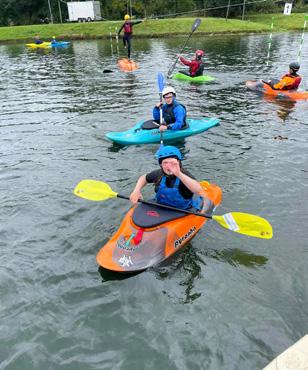
BUDD NEWYDD I AELODAU CC!
Mae'n bleser gennym gyhoeddi budd cyfyngedig i holl aelodau Canŵ Cymru: rydych bellach yn derbyn gostyngiad o 10% ar badlau Ainsworth! Ers dros 35 mlynedd, mae Ainsworth wedi bod ar flaen y gad o ran dylunio a chynhyrchu padlau canŵ a chaiac.
@canoewales
Mae Ainsworth yn ymfalchïo mewn cynhyrchu rhai o'r badlwyr ysgafnaf, cryfaf a mwyaf gwydn sydd ar gael heddiw. Mae eu dewis yn cynnwys opsiynau ar gyfer padlwyr canolradd a pherfformiad, gan sicrhau bod padlo perffaith ar gyfer pob disgyblaeth canŵio a chaiacio. P'un a ydych chi'n broffesiynol a phrofiadol neu'n ddechreuwr brwdfrydig, mae padlau Ainsworth wedi'u cynllunio i wella'ch profiad padlo gydag ansawdd ac arloesedd. I fanteisio ar y cynnig gwych hwn, ewch i wefan Canŵ Cymru i ofyn am eich cod disgownt - www.canoewales.com/discounts. Peidiwch â cholli'r cyfle hwn i uwchraddio eich padl a mwynhau manteision crefftwaith haen uchaf am bris arbennig, dim ond i aelodau Canŵ Cymru. Padlo hapus! www.ainsworthpaddles.co.uk
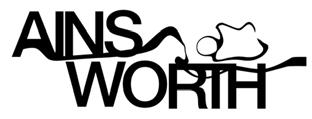
HYSBYSIAD O GYFARFOD CYFFREDINOL BLYNYDDOL CANŴ CYMRU 2024
Mae'n bleser gennym gyhoeddi y bydd Cyfarfod Cyffredinol Blynyddol Canŵ Cymru 2024 yn cael ei gynnal ar-lein trwy Zoom ddydd Mawrth, 12 Tachwedd 2024, gan ddechrau am 7yr hwyr. Yn dilyn y cyfarfod ffurfiol, bydd sesiwn holi ac ateb anffurfiol gydag aelodau o'n Bwrdd Cyfarwyddwyr a Staff, gan roi cyfle gwych i ymgysylltu a gofyn cwestiynau.
Mae gan bob aelod "Ar y Dŵr" ac "Ar y Lan" dros 16 oed hawl i bleidleisio yn y CCB, tra bod croeso cynnes i holl aelodau eraill Canŵ Cymru fod yn bresennol. Gallwch sicrhau eich tocyn am ddim i'r Cyfarfod Cyffredinol Blynyddol drwy archebu ar-lein drwy ein Porth Aelodau. Wrth i ddyddiad y digwyddiad agosáu, byddwn yn anfon dolen Zoom i hwyluso eich mynediad i'r cyfarfod. Bydd dolenni archebu yn cael eu hanfon allan mewn ychydig wythnosau.
I gymryd rhan yn y cyfarfod, bydd angen cysylltiad rhyngrwyd dibynadwy a seinyddion arnoch chi, ac yn ddelfrydol meicroffon a chamera fideo integredig os ydych chi am gymryd rhan weithredol. Mae Zoom ar gael trwy eich porwr gwe, felly nid oes angen unrhyw feddalwedd arbennig. Wrth gofrestru ar gyfer y CCB, rydym yn eich annog i gyflwyno unrhyw gwestiynau ar gyfer y sesiwn holi ac ateb ymlaen llaw i'n helpu i gynllunio'r noson a sicrhau bod ymholiadau pawb yn cael sylw. Bydd swyddogaeth sgwrsio ar-lein hefyd ar gael yn ystod y cyfarfod, ond rhoddir blaenoriaeth i gwestiynau a gyflwynir ymlaen llaw.
Bydd Agenda a Phapurau'r Cyfarfod Cyffredinol Blynyddol ar gael yn agosach at ddyddiad y cyfarfod. Os ydych yn aelod pleidleisio ac yn methu bod yn bresennol, mae gennych hawl i benodi dirprwy i fod yn bresennol a phleidleisio ar eich rhan. Gellir darparu'r holl ddogfennau mewn print bras neu fformatau amgen ar gais.
Cyfarfod Cyffredinol Blynyddol Canŵ Cymru yw eich cyfle i gael y wybodaeth ddiweddaraf am y flwyddyn ddiwethaf a dysgu am ddatblygiadau yn ein sefydliad yn y dyfodol. Eleni, rydym hefyd yn gwneud penderfyniad mawr ar ein brand. Felly, rydym wir yn gobeithio gweld cymaint o aelodau â phosibl i'n helpu i wneud penderfyniad mor bwysig sy'n dylanwadu ar ein dyfodol. Fel bob amser, cewch gyfle i ofyn cwestiynau yn uniongyrchol i'n staff a'n cyfarwyddwyr a chlywed adroddiadau manwl ar ein gweithgareddau a'n cyllid. Bydd ein tîm wrth law drwy gydol y cyfarfod i ateb unrhyw gwestiynau, ar lafar ac yn y sgwrs. Rydym yn edrych ymlaen at eich cyfranogiad a'ch gweld yn y CCB. Am fwy o fanylion, cadwch lygad ar wefan CC: www.canoewales.com
CYRSIAU AR-LEIN NEWYDD PADDLE UK NAWR AR GAEL
Mae Paddle UK wedi lansio dau gwrs ar-lein newydd yn ddiweddar; Y tywydd a'r llanw. Mae'r cyrsiau ar-lein hyn yn ffordd wych o ennill gwybodaeth mewn dau bwnc a all gael effaith enfawr ar badlwyr.
MAE E-DDYSGU TYWYDD ar gyfer unrhyw badlwr, boed yn padlo ar ddyfroedd mewndirol neu arfordirol, sydd am gynyddu gwybodaeth am ragolygon tywydd a sut y gall gwahanol amodau effeithio ar deithiau. Mae'r cwrs un modiwl yn cyflwyno ystyriaethau allweddol i badlwyr a sut i osgoi risgiau o dywydd gwael wrth gynllunio ac ar deithiau. www.bit.ly/3SNriLr
MAE E-DDYSGU'R LLANW ar gyfer padlwyr unrhyw grefft sydd am gynyddu eu gwybodaeth o sut y gall y llanw effeithio ar badlo mewn aberoedd a dyfroedd arfordirol. Mae'n cyflwyno'r pynciau allweddol ar gyfer padlo llanw ac mae'n rhoi enghreifftiau trwy senarios padlo. www.bit.ly/3SNEHmC

Cost i aelodau CC £10 (fel arfer £20 ond mae aelodau'n cael gostyngiad o 50%). Gall aelodau CC hefyd fanteisio ar y cynnig amser cyfyngedig a phrynu'r ddau gwrs am £15: www.bit.ly/4dfAhNs
DARGANFYDDWCH FWY AM EIN BYWYD GWYLLT MOROL ANHYGOEL
Yn ystod yr hydref bydd Cadwraeth Morfilod a Dolffiniaid (WDC) a'r Ymddiriedolaeth Ymchwil y Môr (SRT) yn cyflwyno cyfres o weminarau am ddim gyda PaddleUK am famaliaid morol. Bydd y gweminarau hyn yn eich helpu i ddysgu am ein mamaliaid morol gwyllt anhygoel, beth sy'n eu gwneud mor arbennig, pa mor ddiddorol yw eu bywydau a pha fygythiadau dynol maen nhw'n eu hwynebu. Bydd arbenigwyr mamaliaid morol yn rhannu mewnwelediadau i ymddygiad naturiol, yn ogystal â sut i ymddwyn yn gyfrifol o amgylch bywyd gwyllt morol pan fyddant ar y dŵr.
Gweminar 1 – Medi 24, 7pm – www.bit.ly/3WXJxAy
Gweminar 2 – Hydref 24, 7pm – www.bit.ly/4diKZ5L
Gweminar 3 – Tachwedd 25th, 7pm – www.bit.ly/3WFumKF
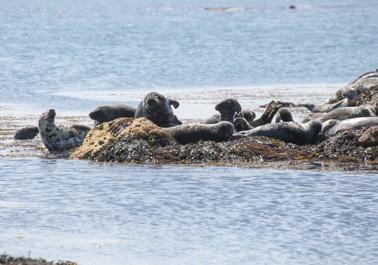
Alistair Dickson CEO
MEMBER SERVICES TEAM
Andy Turton Coaching Manager
Val Ephraim Administrative Officer
Suzanne Parkin Governance & Membership Assistant
Bonnie Armstrong Comms & Marketing Lead
Ellen Roberts Finance Officer
Phil Stone Places to Paddle Manager
Kerry Skidmore Lead Safeguarding and Equality Officer
Lydia Wilford Development Officer
Emily King SUP Lead
PERFORMANCE TEAM
Sid Sinfield Performance Manager
Jonathan Davies Talent Pathway Officer (North)
Gareth Bryant Talent Pathway Officer (West)
James Pigdon Talent Pathway Officer (South)
Giacomo Leighton Slalom Talent Coach
Emily Davies Talent Slalom – North
DIRECTORS
Kerry Chown Chair
Jet Moore Vice Chair
Andy Booth Finance Director
Elsa Davies
Alun Davies
Allan Binstead
Ruth Hall
Tanya Neilson
Dave Kohn-Hollins
David Eade
CONTACT CANOE WALES
www.canoewales.com
admin@canoewales.com 01678 521 199
Canolfan Dŵr Gwyn Genedlaethol, Frongoch, Bala, Gwynedd, LL23 7NU



@canoewales
Well, that summer never really came did it! I hope you enjoyed a fruitful summer period anyway and the rain and wind did not inhibit your paddling adventures too much.
I also hope you really enjoyed the Olympics. I certainly did and I thought the paddling was great to watch. It was also fantastic to watch the success of Team GB in the Slalom and Kayak Cross. The Olympics is clearly in a transition phase where it balances the need to engage with new, younger and more digitally engaged audiences with the need to remain a pinnacle sporting event which continues to test the highest levels of athletic physical and mental performance.
It was clear there were mixed views on the Kayak Cross. However, the number of non-paddlers who have mentioned it me has been surprising. I therefore wonder whether paddlesports is one of the few sports which has managed to balance the traditional competition with a new exciting format successfully. Either way, I feel it has helped to inspire a new generation of participants get involved.
We at Canoe Wales, have just finished a ‘Youth Engagement’ weekend where we ran an activity-packed weekend to highlight to young paddlers the opportunity which paddling presents throughout people’s teenage years and early 20’s. Keeping young people engaged is more of a challenge that is has ever been – there is just so much for people to do now and so much competition for people’s attention. Likewise, young people have clearly heavily been affected by the COVID years and are possibly less inclined to remain involved in pursuits like paddlesport than they once were.
We felt the weekend was a great success, but we know it’s just a start. We therefore ask ourselves how we can do more to inspire the next generation to continue within the sport and enjoy a lifetime of paddling adventures. If you have some ideas, we would love to hear from you. It really feels like an important turning point where we can leverage the power of the Olympics, and we are committed to doing more to keep paddlesports exciting and relevant to a new generation here in Wales. Please get in touch at Alistair.dickson@canoewales.com or one of the team to discuss more.
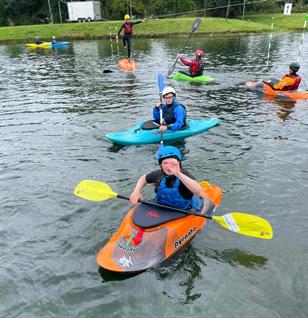
We are thrilled to announce an exclusive benefit for all Canoe Wales members: you now receive a 10% discount on Ainsworth paddles! For over 35 years, Ainsworth has been at the forefront of designing and manufacturing canoe and kayak paddles.
Ainsworth prides itself on producing some of the lightest, strongest, and most durable paddles available today. Their range includes options for both intermediate and performance paddlers, ensuring that there is a perfect paddle for every canoe and kayaking discipline. Whether you're a seasoned professional or an enthusiastic beginner, Ainsworth's paddles are designed to enhance your paddling experience with quality and innovation.
To take advantage of this fantastic offer, simply visit the Canoe Wales website to request your discount code - www.canoewales.com/discounts. Don’t miss this opportunity to upgrade your paddle and enjoy the benefits of top-tier craftsmanship at a special price, just for Canoe Wales members. Happy paddling! www.ainsworthpaddles.co.uk

We are pleased to announce that the 2024 Annual General Meeting of Canoe Wales will take place online via Zoom on Tuesday, 12 November 2024, starting at 7 pm. Following the formal meeting, there will be an informal Q&A session with members of our Board of Directors and Staff, providing an excellent opportunity to engage and ask questions.
All "On the Water" and "On the Bank" members over the age of 16 are entitled to vote at the AGM, while all other members of Canoe Wales are warmly welcome to attend. You can secure your free ticket to the AGM by booking online through our Member Portal. As the event date approaches, we will send out a Zoom link to facilitate your access to the meeting. Booking links will be sent out in a few weeks.
To participate in the meeting, you will need a reliable internet connection and speakers, and preferably an integrated microphone and video camera if you wish to actively participate. Zoom is accessible via your web browser, so no special software is required.
When registering for the AGM, we encourage you to submit any questions for the Q&A session in advance to help us plan the evening and ensure everyone's queries are addressed. An online chat function will also be available during the meeting, but priority will be given to questions submitted beforehand.
The AGM Agenda and Papers will be available closer to the meeting date. If you are a voting member and unable to attend, you have the right to appoint a proxy to attend and vote on your behalf. All documents can be provided in large print or alternative formats upon request.
The Canoe Wales AGM is your chance to receive updates on the past year and learn about future developments within our organisation. This year, we are also making a major decision on our brand. We therefore really hope to see as many members there as possible to help us make such an important decision influencing our future. As always, you will have the opportunity to ask questions directly to our staff and directors and hear detailed reports on our activities and finances. Our team will be on hand throughout the meeting to answer any questions, both verbally and in the chat.
We look forward to your participation and seeing you at the AGM.
For more details keep an eye on the CW website: www.canoewales.com
NEW PADDLE UK ONLINE COURSES NOW AVAILABLE
Paddle UK have recently launched two new online courses; Weather and Tides. These online courses are a great way to gain knowledge in two subjects that can have a huge impact on paddlers.
WEATHER ELEARNING is for any paddler, whether paddling on inland or coastal waters, wanting to increase knowledge of weather forecasting and how different conditions can affect trips. The single-module course introduces key considerations for paddlers and how to avoid risks from poor weather when planning and on trips.
www.bit.ly/3SNriLr
TIDES ELEARNING is for paddlers of any craft who want to increase their knowledge of how tides can impact paddling in estuaries and coastal waters. It introduces the key topics for tidal paddling and uses gives examples through paddling scenarios.
www bit.ly/3SNEHmC

Cost for CW members £10 (usually £20 but members get a 50% discount). CW members can also take advantage of the limited time offer and buy both courses for £15: www.bit.ly/4dfAhNs
DISCOVER MORE ABOUT OUR AMAZING MARINE WILDLIFE
During the autumn Whale and Dolphin Conservation (WDC) and the Sea Research Trust (SRT) will be presenting a series of free webinars with Paddle UK about marine mammals. These webinars will help you learn about our amazing marine mammal wildlife, what makes them so special, how interesting their lives are and what human threats they face. Marine mammal experts will share insights into natural behaviour, as well as how to behave responsibly around marine wildlife when on the water.
Webinar 1 – Sept 24th, 7pm – www.bit.ly/3WXJxAy
Webinar 2 – Oct 24th, 7pm – www.bit.ly/4diKZ5L
Webinar 3 – November 25th, 7pm – www.bit.ly/3WFumKF


WORDS: SARAH-KAY PURDON AND OLIVIA PARGETER, RSPB CYMRU
PHOTOS: COURTESY OF RSPB CYMRU OR AS CREDITED
Sarah-Kay Purdon and Olivia Pargeter work for RSPB Cymru on the Biosecurity for Wales project, which is funded by the Nature Networks Programme (delivered by the Heritage Fund, on behalf of the Welsh Government).
Welsh islands are globally important for breeding seabirds.
As frequenters of Wales’ coastline, you know how fortunate we are to be surrounded by such varied, and biodiverse landscapes. The small islands dotted off our coast and the amazing wildlife that calls them home are the jewel in the crown.
Have you ever wondered why these islands attract so many seabirds? While seabirds are perfectly adapted to a life at sea, on land they are clumsy and vulnerable. To reduce the risk of predation from their natural predators (those which have evolved alongside each other in the same habitats) some species, such as Manx Shearwater, only return to land under cover of darkness when the gulls and skuas who pose them the greatest predatory threat, are less active. Others have evolved to nest in dense colonies taking advantage of ‘safety in numbers’ to protect their eggs and chicks.
However, these evolved defences are useless against mammalian predators which can follow birds into their burrows and are agile enough to clamber about on cliffs. These islands are havens for seabirds because of the absence of mammalian predators such as rats, cats, stoats, hedgehogs and mink.
Invasive predators can quickly decimate breeding colonies by eating eggs, chicks, and adult birds. One pregnant female brown rat can produce a population of 300 individuals in around eight months. It is vital that we stop them reaching these important islands.
Wales’ responsibility for the fate of UK seabirds has never been greater, as while globally and nationally, many seabird populations have been declining, Wales, in several cases has been bucking this trend (prior to the current avian flu outbreak). SPECIES
Herring gull
3rd largest gannetry in world! Manx shearwater
Half of world's population
Seabirds in Wales are concentrated on a small number of islands, with 13 islands designated as an SPA (special protected area) or
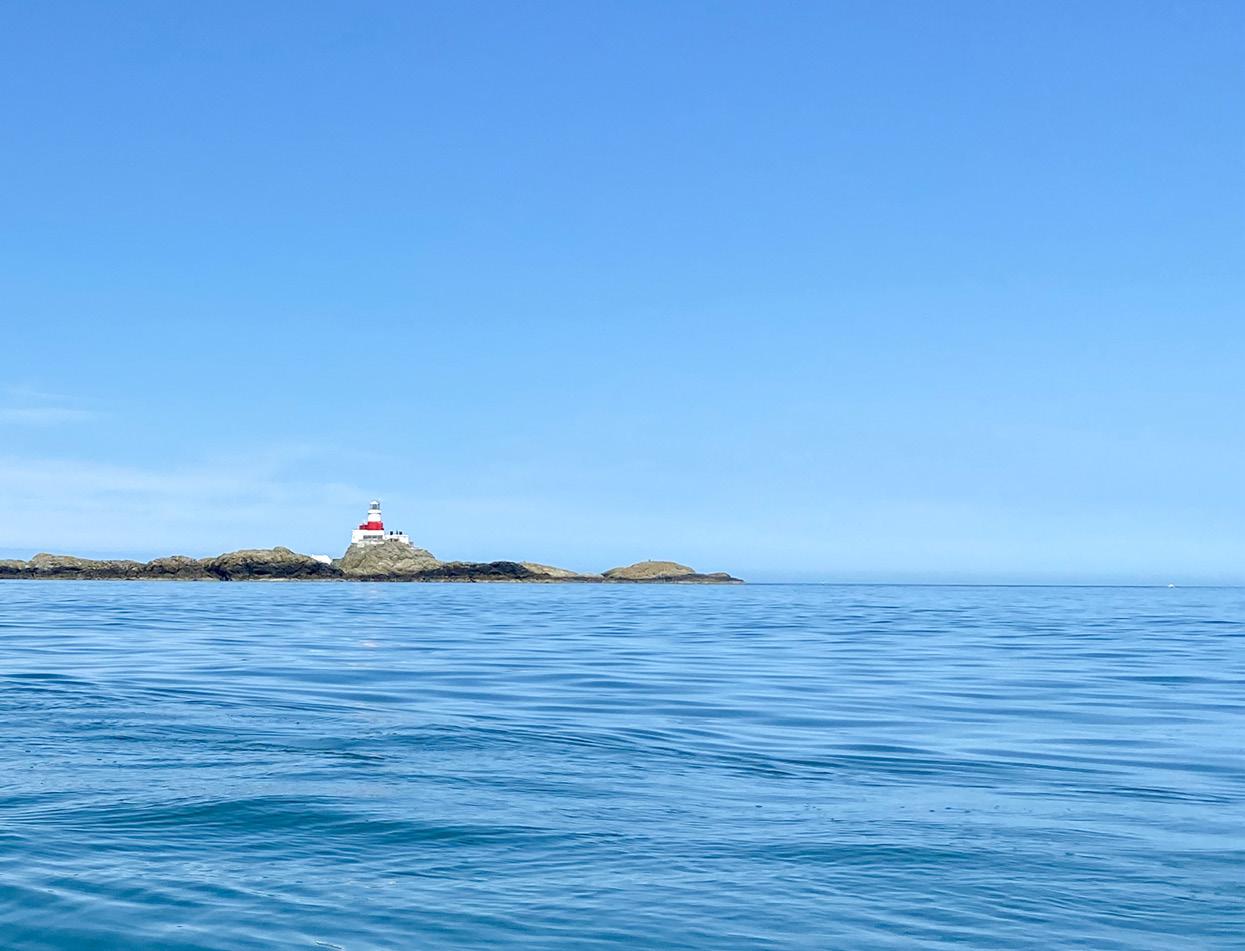
SSSI (site of special scientific interest) for seabirds. Having such important numbers of seabirds concentrated on a small number of islands makes their populations especially vulnerable.
Wales’ seabird islands pulsate with life yet these precious offshore sanctuaries face a silent threat: invasive predators like rats.
Rats have arrived on many seabird islands due to human activity, largely the transport of cargo, or through shipwrecks. This occurred on Ramsey Island, with rats arriving via shipwrecks in the 1800s. Puffins were soon wiped out on the island, and while manxies remained, they were unable to raise any chicks, and are thought to have only endured due to the continual topping-up of birds from Skomer and Skokholm islands, whose populations were expanding. In the 1990s, the RSPB Ramsey Island team embarked on a programme to remove rats from the island. The results of the eradication programme were remarkable, with Manx Shearwater numbers rocketing from a few hundred to 6,225 pairs in just a few years.
The impacts of rats on seabird islands can be long-lasting. Puffins are incredibly social and loyal birds, with adults returning to the same colony (sometimes even the same burrow) to breed each year, and youngsters visiting existing colonies to find mates and burrows. This means they are incredibly slow to (re)establish sites, preferring to grow existing colonies. Despite the good habitat and efforts from the island wardens, puffins have yet to return to breed on Ramsey.
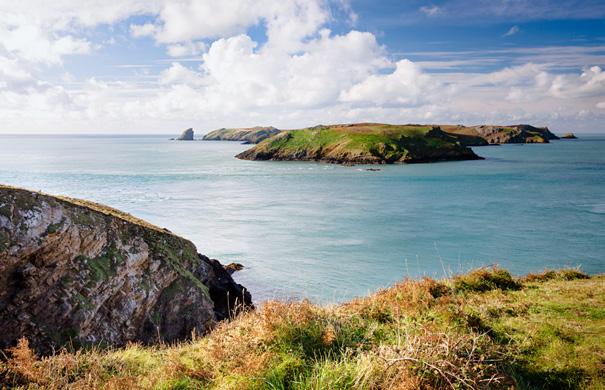

Biosecurity aims to PREVENT an invasive predator reaching seabird islands, but if this fails, we DETECT an incursion quickly and RESPOND before an eradication is needed.
Shipwrecks are less common than they used to be, but accidental boat groundings still occur regularly, for example the lifeboat from a tanker which was lost during a routine exercise in May this year.
From a wildlife perspective, preventing rats from establishing on an island is far better than attempting to eradicate them once established. This is also true from a human perspective, as the resources required to complete an effective eradication are many times greater than what is required to prevent arrivals. Recent projects to eradicate rats from seabird islands around the UK have cost around £1,000,000 per site. Eradications take years to plan and seabird numbers continue declining between discovering that rats have colonised and beginning an eradication. Eradications are not always successful.
If an invasive predator reaches a seabird island, we need an early warning system and routine surveillance on islands, as they tend to maintain a low profile until the population has grown substantially. We have several methods of surveillance, including trail cameras and chew marks, but none are 100% reliable as they are “passive”, relying on the behaviour of the animal to enable detection.
We also have a conservation detection dog called Jinx. Jinx’s nose has up to 300 million olfactory receptors – compared to a measly six million in humans and the area of his brain dedicated to analysing smells is around 40 times greater than ours. All of this means that he has an amazing sense of smell and can smell things that we can’t. He can pick out and locate the smell of a single rat or dropping amongst all the other smells on an island. He does not catch or kill rats, his job is to indicate the presence of a rat so that we can implement an incursion response. Conservation detection dogs are used worldwide and are growing in popularity for noninvasive monitoring of sensitive or cryptic species.
Jinx and his handler Greg head out to islands to check that no rats have snuck passed our other biosecurity measures, they can
also check boats before they sail over to the islands to make sure that they aren’t carrying any rats. Jinx is currently our only ‘active’ method of detecting rats.
Over the past year, Greg and Jinx have carried out routine biosecurity checks on Flat holm, The Skerries, Caldey, Ramsey, Skokholm and Skomer. They also took part in an incursion response on Skokholm following the grounding of an oil tanker’s lifeboat on the island. In all cases the islands received a clean bill of health, and no signs of rats were detected. They have also been busy checking boats and cargo before they leave mainland to head over to the islands to ensure that there are no stowaways on board.
Seabirds are under pressure from many threats including:
» Highly Pathogenic Avian Influenza (bird flu)
» Climate change
» Accidental bycatch (being caught accidentally by fishing practices)
» Invasive non-native species
» Lack of food due to overfishing
» Offshore renewable energy infrastructure
Many of these pressures are human generated and we have a responsibility to alleviate what pressures we can. Highly Pathogenic Avian Influenza (bird flu) is an additional threat to seabirds. Bird flu
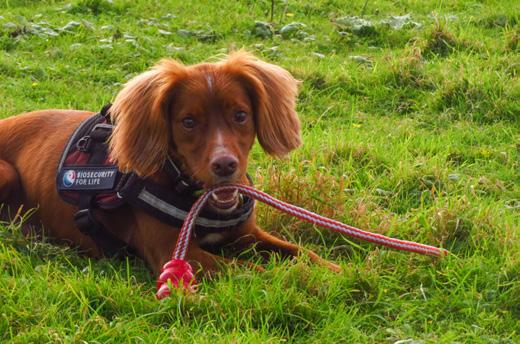
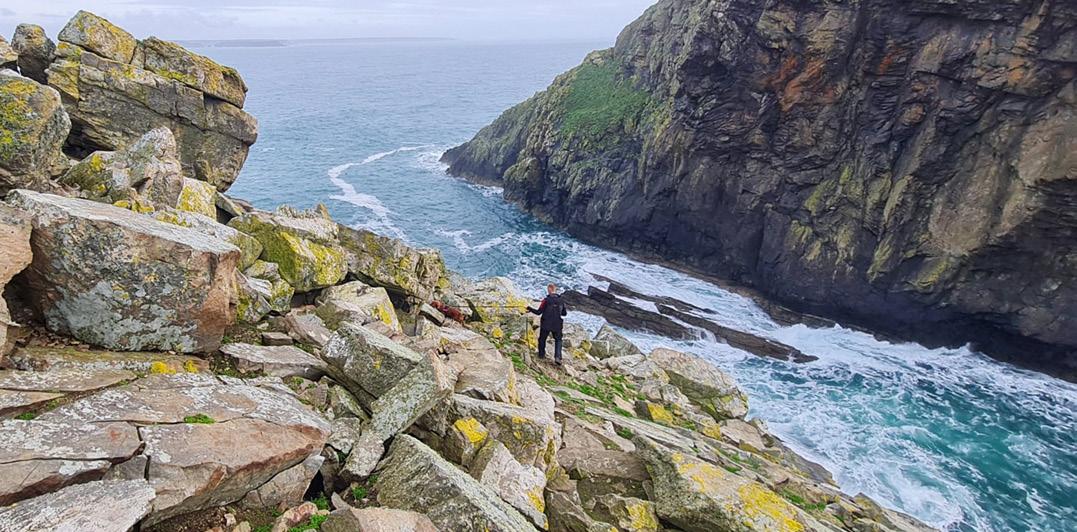
has had a devastating impact on seabirds, causing the number of gannets nesting on Grassholm to plummet by a massive 52%, from 34,491 in 2022 to 16,482 in 2023.
Bird flu has not replaced the other pressures that seabirds were already facing. Alleviating pressures has never been more important for the surviving populations to stand a chance of recovering. Seabirds are long lived, slow to reach breeding age and many species only rear a maximum of one chick each year. This means that when adults die in large numbers the populations cannot breed fast enough to make up for the losses and species go into steep declines.
If an invasive predator is found on a seabird island, a rapid response is critical. Two regional Rapid Incursion Response Hubs have been established in Wales which contain everything required for responding to an incursion. To operate these hubs, we are training teams of volunteers. If you would like to find out more about being a part of our incursion response team head to our website.
Biosecurity is integral to ensuring that surviving adults have a safe place to rear their young. To stand a chance in a changing world, seabirds require their breeding grounds to remain free from predatory mammals.
Anyone travelling to a seabird island or in the vicinity of a protected seabird island has a responsibility to undertake basic checks before setting off and implement biosecurity measures.
Always check, clean, dry. Never land on an island without permission.
If you have found signs of a stowaway onboard your kayak, do not land on a rat-free island. Never push a stowaway overboard, most mammals are strong swimmers – brown rats can swim up to 4km! Never assume that there was only one stowaway aboard. You should return to mainland and check all boats and bags.
Use the checklist below next time you head over to an island:. If you would like a kayak sticker to remind yourself and others of the importance of biosecurity, send us an email in the 'contact us' section of the website!
TO KEEP THESE ISLANDS SAFE, WE NEED YOUR VOICE!
Share your thoughts in a quick survey (5 minutes) about biosecurity measures on these island sanctuaries. By sharing your opinions and knowledge, you'll play a crucial role in shaping how we protect these majestic birds. Scan this QR code or visit our this site to find out more: www.bit.ly/4dBNMqu

MORE INFO for stacks of useful information on biosecurity including advice, guides and posters, plus stickers for your paddlecraft visit: www.biosecurityforlife.org.uk
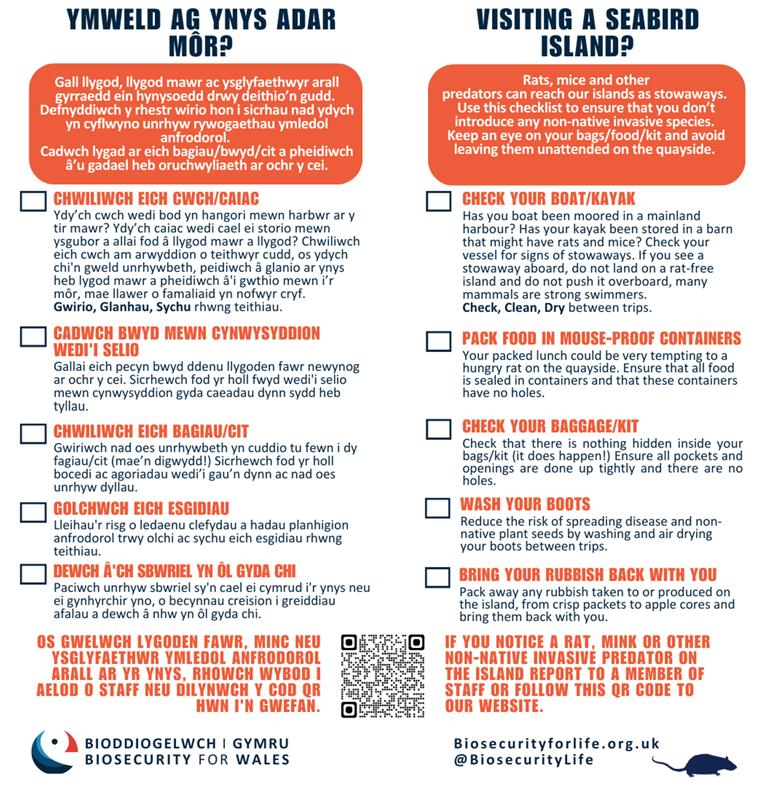




Sid joined the CW team in May, as our new Performance Manager, and brings with him a wealth of expertise. He has been on the paddlesport scene for over 35 years, as a recreational and competitive paddler, and as a coach; working as a Senior Instructor at Plas y Brenin for 12 years, and more recently as the Performance Coach Developer for Paddle UK’s Worldclass (Olympic and Paralympic) Programme. He also holds Master’s Degrees in Performance Coaching and Elite Performance, along with a Post Graduate Diploma in Coach Development. Which makes him the perfect fit for the role of CW Performance Manager. Ceufad gave him the standard grilling to find out more …
“I HAVE ALWAYS BEEN DRAWN TO HELPING OTHERS DEVELOP. ORIGINALLY I WAS A TEACHER AND THIS LED ME INTO COACHING. I ENJOY WATCHING OTHERS DEVELOP AS A RESULT OF MY COACHING ALMOST AS MUCH AS I ENJOY DOING IT MYSELF!”
How and when did you start paddling?
As a young boy growing up in East London in the 1980s I was introduced to paddling on a muddy ditch in Barking. I think it’s safe to say it wasn’t the wildlife and natural environment that I was drawn to at first! I can still recall the smell from the chemical factory and the ‘interesting’ things that used to wash down the river from the estates upstream. But despite this I loved being afloat and always have. I enjoyed the different perspective the river gave me on where I lived and the freedom and ability to explore. Paddling downstream to the mighty Thames felt like such an adventure! I owe such a debt to an inspirational schoolteacher who used to drive us to the regular weekly sessions. Without his efforts I doubt would have found such an important part of my life.
What are your preferred disciplines and why?
This is such a difficult question for me because what I love about paddling is the variety. I love exploring new bits of coastline, I love the thrill and challenge of whitewater or surfing. Expeditioning in remote places is so enjoyable as is being around developing athletes and seeing them reap the reward from all their hard work and application. Paddling is and has been such an important part of my life that it is very difficult for me to choose which aspect I like most.
You’ve competed in surf kayak – what was your best achievement?
I managed to reach the quarter finals of the World Championships in Mundaka and Bakio in Northern Spain back in 2007. The surf was so big on finals day I have to say I was quite relieved I hadn’t made it!
What led you to coaching?
I have always been drawn to helping others develop. Originally I was a teacher and this led me into coaching. I enjoy watching others develop as a result of my coaching almost as much as I enjoy doing it myself! I really appreciate what paddling has given me. I also appreciate the role my teacher and subsequent coaches have played in that journey. This drives me to want to share my knowledge and understanding with others and help them on their journey.
Why did you take the role of Performance Manager?
I have, for many years, had a close relationship with paddling in Wales. Over the years I have also developed quite a broad skillset and understanding of the performance environment. When I saw the opportunity to work in Wales and utilise my skills to help develop the young aspiring athletes here it was too good to pass up.
What does it involve?
In essence I coordinate the activities of the Performance Programme to try to make the development of our athletes optimal. This could include coordinate the training programmes on and off the water, organising camps and competition support, supporting our coaches with their development, trying to ensure we maximise our activities within our budget constraints etc. All this is done with a view to try to ensure that the athletes have the opportunity to be as good as they want to be.
What do you hope to achieve?
I want to ensure all the young athletes get the opportunity to be as good as they want to be. That they enjoy their time racing and look back on it fondly. If they win medals on the way that would be

great. I’d love to see us punching above our weight within the GB team but equally important I want to see smiling faces on people enjoying racing. A happy athlete is a fast athlete, and fast athletes win races!
What are the challenges?
Success is always dependent on consistent and considered application and being exposed to optimal experiences. The application is down to the athletes, but my challenge is to try to inform what is considered and facilitate consistent optimal experiences. Whilst we have lots of usable resources in Wales we do have to travel quite frequently to other parts of the UK and Europe. The cost of this can be difficult for both the families of the young athletes and us as a programme. Finding a workable compromise is where the challenge lies. But history has shown us many times that athletic success often involves coming to terms with adversity and finding a solution.
If you could give 3 pieces of advice to a young athlete, what would they be?
1. Don’t just focus on the gaps in your performances. Take time to acknowledge what you can do. All too often people focus on the one mistake and not the 90% done well.
2. Remember the power of ‘yet’. A growth mindset is key to continued incremental improvements. By acknowledging the ‘yet’ you are framing your development as a journey and not a ‘do’ or ‘do not’ binary thing. “I can’t do that yet, but if I work on this and this I will be able to.”
3. Remember to have fun and be grateful for what you have! Take time to smile, chat, feel the flow of the river and the total absorption paddling gives us. If you are enjoying what you are doing, you’ll want to do it more. And so will those around you. Thank those who support you – don’t take your parents or carers for granted!
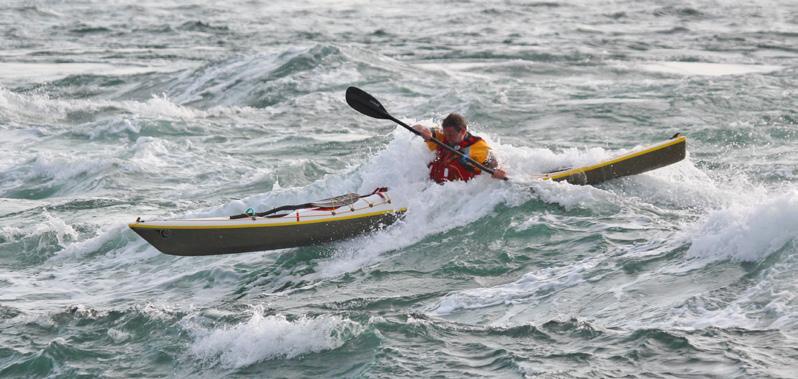
“I’D LOVE TO SEE US PUNCHING ABOVE OUR WEIGHT WITHIN THE GB TEAM BUT EQUALLY IMPORTANT I WANT TO SEE SMILING FACES ON PEOPLE ENJOYING RACING. A HAPPY ATHLETE IS A FAST ATHLETE, AND FAST ATHLETES WIN RACES!”
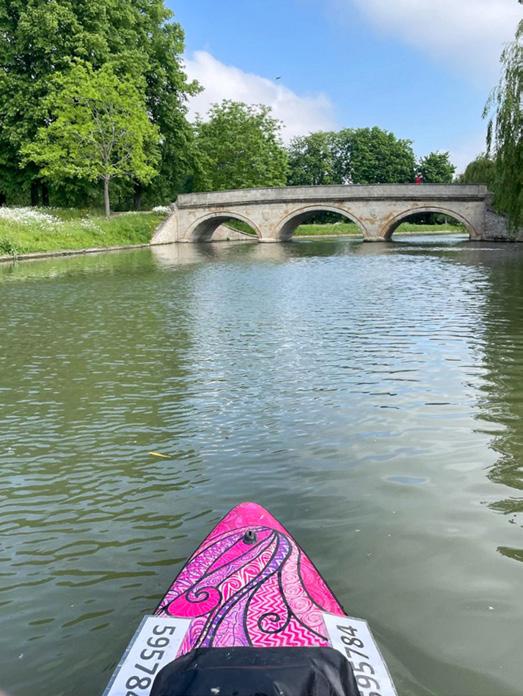
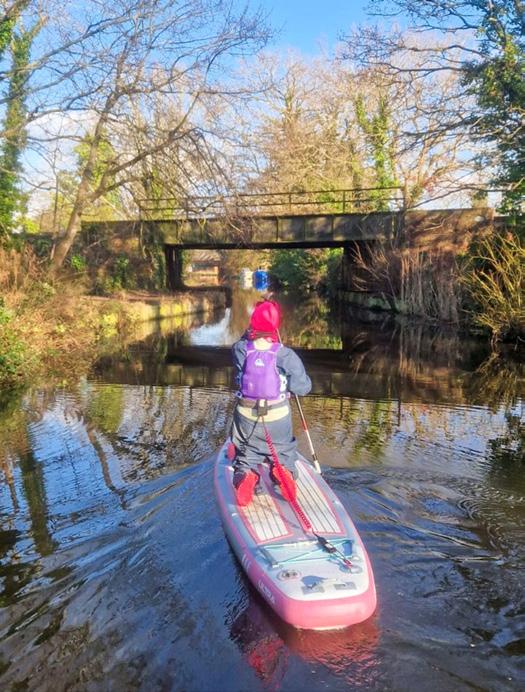
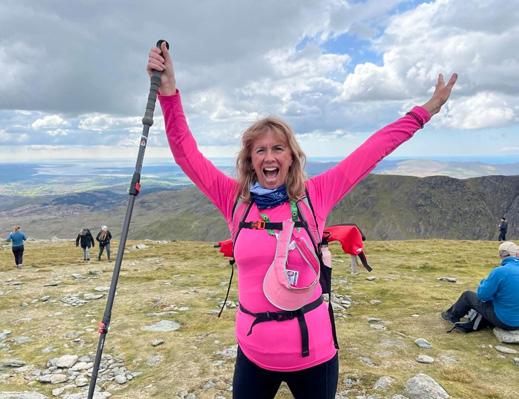

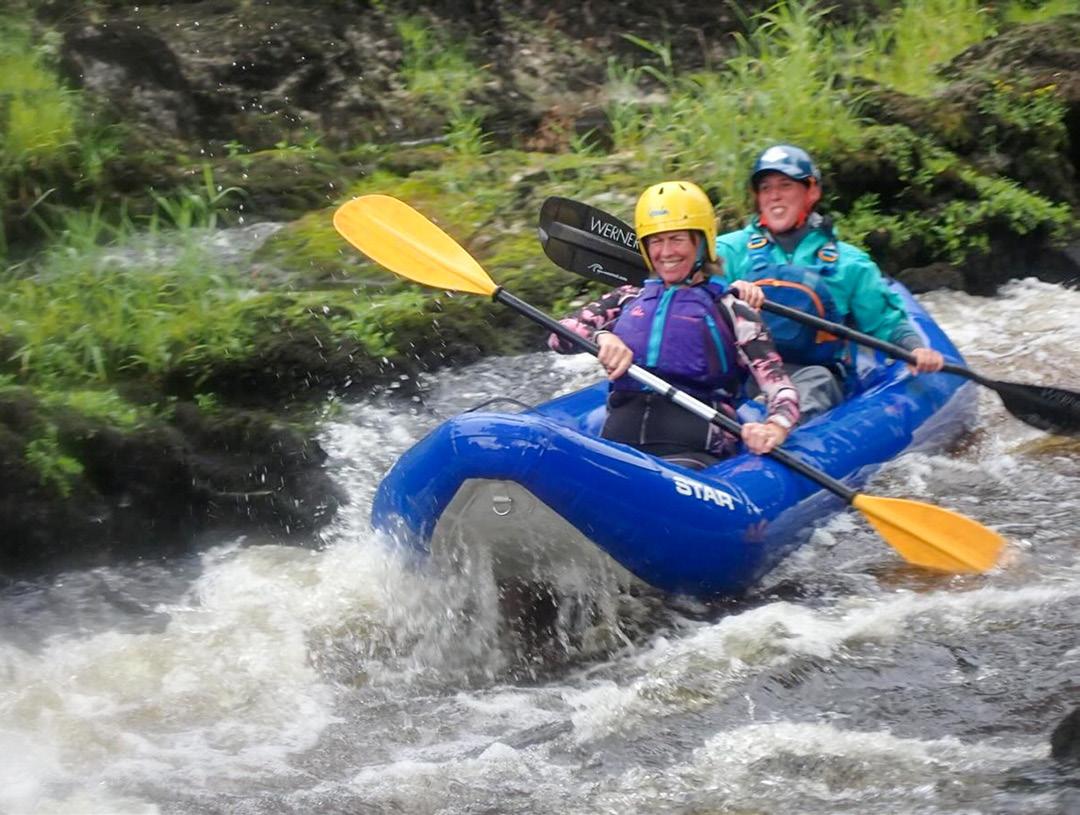
Born in Omagh Co. Tyrone, Cathy moved to London in 1983 where she met the man of her dreams, got married and had 5 beautiful children. Cathy was a swimming teacher and coach who went on to study History & History of Science, returning to complete an MSc in Science Communication & Society. She then become a special needs teacher, following in her father’s footsteps. This is when her life changed; a brain haemorrhage.
Cathy was exercising several times a week when she was struck by the worst headache of her life, which turned out to be a brain haemorrhage. This then happened again, with her husband finding her unconscious on the bedroom floor, resulting in a helicopter transfer, not waking up for 2.5 weeks, and being paralysed down her right-hand side.
At this point her husband was asked if he would like to let her ‘slip away’, but the thought of her coming back to haunt him was too much and he said 'no'!
This led to Cathy's determination to get her through intense rehab.
The first thing her ‘physio-terrorist’ asked her to do was to climb a flight of stairs. How was that even a thing? She didn't want to appear unwilling but honestly … she might as well have asked her to climb Everest. But being Cathy, she did it! Then began physiotherapy, occupational therapy,
speech and language therapy, hydrotherapy and massage therapy.
Then, after retaking her driving test and with her sunflower lanyard and identity card around her neck due to communication difficulties and challenges, she was ready to take on the world once again.
Cathy still had mobility issues in her upper right arm and right leg, but the worst thing she had to deal with was being doubly incontinent and have no feeling or urge to go. She just goes. Cathy was angry. Why her?
However, lots of hard work on her part meant she could attend her first paddleboarding lesson in November 2020.
Cathy had a reasonable adjustment from Paddle UK that meant she didn’t have to stand. She can’t always guarantee that she will be able to place both her feet at 12 o’clock. Sometimes
“CATHY WAS EXERCISING SEVERAL TIMES A WEEK WHEN SHE WAS STRUCK BY THE WORST HEADACHE OF HER LIFE, WHICH TURNED OUT TO BE A BRAIN HAEMORRHAGE. THIS THEN HAPPENED AGAIN, WITH HER HUSBAND FINDING HER UNCONSCIOUS ON THE BEDROOM FLOOR."

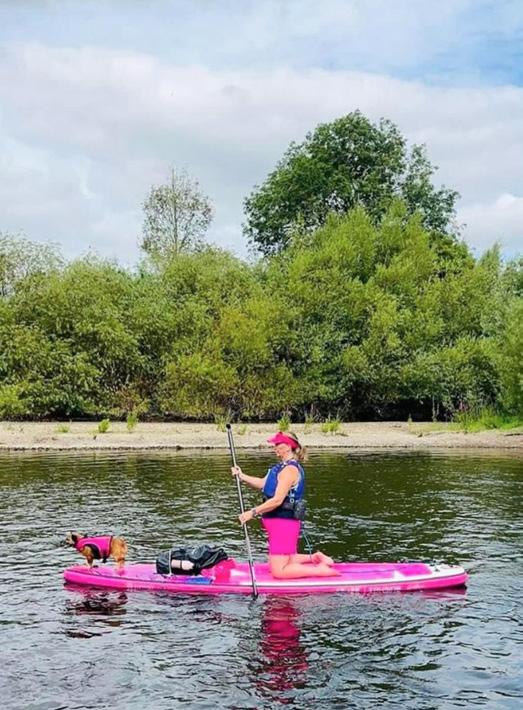
“WE HAD A CHAT ABOUT WHAT I ACTUALLY WANTED TO DO AND I SUDDENLY FOUND MYSELF HURTLING DOWN A SERIES OF RAPIDS ON A GIANT LIFE RING! AKA DONUT-ING OR ARC-ING. FOLLOWED BY AN AFTERNOON IN A HOTDOG COMING DOWN THE EXACT SAME RAPIDS!!! IT WAS SOOOO GOOD I DID IT TWICE!”
her right foot decides it will go to 3 o'clock and nothing will move it.
Cathy does not do things by halves and in 2022 became a Paddle UK ambassador for ShePaddles. She is obsessed with paddleboarding. It gets her out of the house and benefits her mental health enormously. She tries to go paddling at least 3 times a week, if not more.
Feeling on top of the world Cathy was able to return to her other love, running. And then completed The Medway Canoe Trials 33km paddle. Finding it extremely difficult to communicate because of aphasia, Cathy often came across as rude and abrupt, with her nearest and dearest often ending up bearing the brunt of her lack of filter.
This is where the_disabled_paddler began to share her story.
Cathy is a prime example that if you want it badly enough then you can do it!
Cathy’s next step was to attend the #ShePaddles Cymru Summer Celebration Festival and this is her description of the event:
Wow! Just wow!
I’m still buzzing from what has just been the best weekend ever! I was slightly nervous about going to the weekend but honestly it was all in my head. My biggest fear was that my first-choice activities were not available, I booked 3 days before, (my 2nd and 3rd choices weren’t either) so I was allocated
An Intro to SUP Racing and Rescues (which I had actually requested). On arrival I was warmly welcomed by Lydia, shown where to park so I could hook my van up. Then I had 30mins or so to pump my board up.
Emily King, who I had the pleasure of meeting in February, had suggested I come along to the #ShePaddles Summer Festival, so I was absolutely thrilled that she would be delivering the Intro to SUP Racing. We had a chat about what I actually wanted to do and I suddenly found myself hurtling down a series of rapids on a giant life ring! AKA donut-ing or arc-ing. Followed by an afternoon in a HotDog coming down the exact same rapids!!! It was soooo good I did it twice!!
Sunday was a gentle river paddle with a couple of little rapids which I was given the option to portage round but declined. So, fully expecting to go in, I managed both times to stay on my board (although I did get wet!). Cue the biggest smile on my face.
Go on you know you want to. Just do it!
Then, 7 years after Cathy’s injury, she has retired the_disabled_paddler. Again, Cathy's words explain this the best way possible:
So today is exactly 7 years since I was Air Ambulanced to Kings Hospital in London (see my Instagram post) and I've retired the_disabled_ paddler and, because of you and your crew, I have

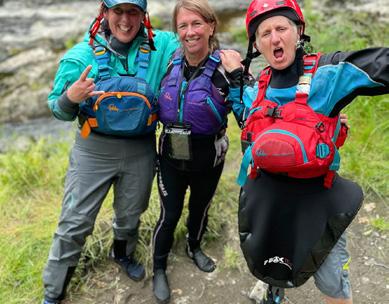



changed my new insta to she_who_dare_wins. I was completely blown away by how I was treated at the #ShePaddles Cymru weekend where my disability wasn't mentioned (except by me). I was treated just like everyone else. I have spent the last 7 years feeling excluded from activities that I wanted to try. I've been fobbed off with excuses like ‘our insurance wouldn't cover you for that’, or ‘has your doctor said you could do this or that’ and ‘maybe next time’ … I was so overwhelmed by your inclusivity. Couldn't believe that Joey was willing to let me try arc-ing. And Claire (a ShePaddles Cymru Volunteer and past Ambassador) was prepared to come in the double HotDog with me. I just felt so alive and exhilarated and humble. I have faced the most horrendous discrimination imaginable from people not "seeing" me when I was in a wheelchair and talking to whoever was pushing me as though I didn't exist and asking my carer how I was to being denied the opportunity for upper limb rehab because I couldn't shrug my right shoulder - I bypassed them! I can’t wait to see you all again next year.
We are all super looking forward to what Cathy does next and love being part of her journey.
“I WAS COMPLETELY BLOWN AWAY BY HOW I WAS TREATED AT THE #SHEPADDLES CYMRU WEEKEND WHERE MY DISABILITY WASN'T MENTIONED (EXCEPT BY ME). I WAS TREATED JUST LIKE EVERYONE ELSE … I WAS SO OVERWHELMED BY YOUR INCLUSIVITY."

Yn gynharach eleni cysylltwyd â Chlwb Canŵio Amlwch a gofynnwyd a fydden ni'n hoffi cymryd rhan yn Niwrnod Codi Arian ac Ymwybyddiaeth Diogelwch blynyddol y SBCBA (RNLI) ar 26ain o Fai.
Helen a Dave Martin oedd yn arwain ar y sesiwn; yn coladu taflenni a gwybodaeth am ddiogelwch ar y dŵr lle mae sy’n ymwneud â chwaraeon padlo.
Cyrhaeddodd y diwrnod yn briodol a, gyda thywydd nodweddiadol Gŵyl y Banc, roedd y bore yn 'wlyb ac yn ddiflas'. Ni wnaeth hyn atal sawl aelod rhag cyrraedd yn gynnar i godi’r stondin.
Roedd gan Helen a Dave gymhorthion hynofedd dethol, fflerau ac offer diogelwch. Ynghyd â phosteri wedi'u lamineiddio gyda phob math o gyngor ar denynnau PAD (SUP), map y SBCBA (RNLI) o’r arfordir o amgylch Ynys Môn, gwahanol fathau o gymhorthion hynofedd, cyngor ar ddiogelwch dŵr, tywydd ac ati. Roedd Claire wedi gwisgo yn yr hyn rydyn ni'n ei argymell ar gyfer padlo diwrnod; siwt gwlyb, cag a chymorthyn hynofedd, fel y gallai pobl weld y cit rydyn ni'n ei ddefnyddio.
Wrth i'r bore fynd yn ei flaen roedd yna lif cyson o ymwelwyr Gŵyl y Banc yn cerdded ar hyd wal yr harbwr, nifer yn stopio i edrych ar fwrdd CC Amlwch a gofyn nifer o gwestiynau llwyddwyd eu hateb rhyngom ni i gyd. Yn ffodus, nid oedd unrhyw gwestiynau 'caled' neu waith cartref.
Yn ystod y cyfnodau tawelach, cynhyrchodd Helen, fel consuriwr, danteithion pobi cartref o'r tu ôl i'r bwrdd gan droi bore llaith yn un heulog.
Erbyn amser cinio roedd yr ymwelwyr yn dod allan o'u cartrefi gwyliau cynnes ac roedd yr haul yn gwneud ymddangosiad. Amseru perffaith wrth i ddau fad achub, un o Gaergybi ac un o Foelfre, ymddangos allan yn y bae.
Buan iawn roedd yr harbwr yn llenwi â phobl ac erbyn hyn roeddem yn brysur yn ateb cwestiynau ar radios amledd uchel iawn (VHF), tenynnau PAD (SUP), cymhorthion hynofedd, gwahanol fathau o fflerau a'r hyn y byddem yn cynghori pobl i'w brynu. Gobeithio bod ein manwerthwr lleol yn ein cofio ni am gomisiwn!
Ymddangosodd ciwiau hir gyda phobl yn aros eu tro i edrych o gwmpas y badau achub. Roedd y SBCBA (RNLI) a Gwylwyr y Glannau yn brysur gyda'u stondinau ac yn rhoi cyngor. Rwy'n siŵr y byddant wedi codi nid yn unig arian ond, yn bwysicach, ymwybyddiaeth o ddiogelwch ar y dŵr. Wrth i'r prynhawn ddirwyn i ben a thra bod torfeydd yn yr harbwr o hyd, gwnaeth tri aelod o'r clwb – Daf Williams, David Thornton ac Andy Wallace - arddangosiad mewn caiacau o sawl math o achubiaethau
yr ydym yn ymgymryd â hwy. Roedd y rhain yn cynnwys achub Esgimo, ail-fynediad bachyn sawdl, achubiaeth dymchwel popeth, llaw Duw, ac ar y diwedd, rhôl.
Fe wnaeth Helen wylio'r senarios o falconi a darparu sylwebaeth; gyda disgrifiad byr o'r hyn roedd y triawd dewr yn ei wneud. Roedd y gymeradwyaeth gan y dorf yn cadarnhau'r ymdrech roedd y tri 'rhai gwlyb' wedi ei wneud.

Fel pe bai wedi'i gynllunio (nid oedd) fe ymddangosodd teulu yn yr harbwr ar un PAD (SUP); dim ond un yn gwisgo cymorthyn hynofedd a gyda'r PAD (SUP) yn amlwg yn cael ei orlwytho. Fe atgyfnerthodd y neges yr oeddem ni a'r SBCBA (RNLI) wedi bod yn ei hyrwyddo drwy'r dydd.
Er bod y diwrnod o ran y tywydd wedi dechrau’n llaith, erbyn diwedd y dydd roedd gennym LAWER o bobl yn edrych ar ein hoffer diogelwch, y posteri ac yn gofyn LLAWER o gwestiynau, ac roedden ni yn gallu eu hateb i gyd. AC roedd yr haul yn tywynnu ac erbyn hyn roedd tuniau cacennau Helen bron yn wag.
Roedd yn wych bod y clwb yn rhan o'r digwyddiad hwn, ac roedd yn ymddangos fel pe baem wedi cael effaith gadarnhaol. Felly, os oes unrhyw glybiau eraill yn ystyried gwneud rhywbeth tebyg, byddwn yn ei argymell yn fawr.
Diolch ENFAWR i Helen a Dave Martin am drefnu ein rhan yn y gwahoddiad, a diolch yn fawr iawn i David Thornton, Andy Wallace a Daf Williams am eu harddangosfeydd o achub.
Gobeithio y byddwn ni, ynghyd â'r SBCBA (RNLI), wedi helpu pobl i aros yn fwy diogel ar y dŵr.
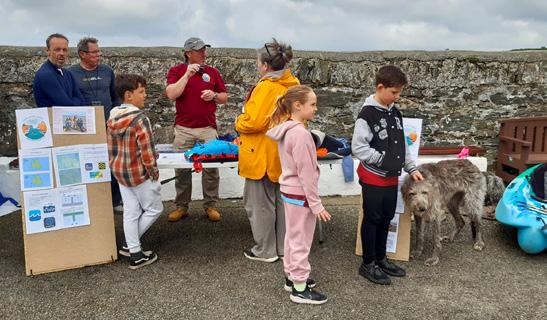
Dave Martin yn rhoi cyngor ar chwaraeon padlo ac ar y chwith Daf ac Andy yn paratoi eu hunain am eu 5 munud o enwogrwydd gyda'r arddangosfa o achubiaethau ac ati.


ARTICLE: PHIL EDWARDS, L3 COACH
Earlier this year Amlwch CC were approached and asked if we would like to participate in the annual RNLI Fund Raising and Safety Awareness Day on the 26th of May.
Helen and Dave Martin took the lead on the session; collating leaflets and information on safety on the water where paddlesports are involved.
The day duly arrived and, with typical Bank Holiday weather, the morning was ‘wet n orrid’. This didn’t deter several members from arriving early to set the stand up.
Helen and Dave had a selection buoyancy aids, flares and safety equipment. Along with laminated posters with all sorts of advice on SUP leashes, the RNLI’s map the coast around Anglesey, different types of buoyancy aids, water safety advice, weather etc. Claire was attired in what we recommend for a day paddle; wet suit, cag and buoyancy aid, so people could see the kit we use.
As the morning progressed there was a steady trickle of Bank Holiday visitors bimbling along the harbour wall, many stopping to look Amlwch CC table and asking a number of questions which between us all we were able to answer. Luckily no ‘hard sums’ or homework questions.
During the quieter patches Helen, magician-style, produced some homemade baking from behind the table turning a damp morning into sunnier one.
By lunch time the holiday makers were coming out of their warm holiday homes and the sun was making an appearance. Perfect timing as two lifeboats, one from Holyhead and one from Moelfre, appeared out in the bay.
The harbour soon filled with people and by now we were busy answering questions on VHF radios, SUP leashes, buoyancy aids, different types of flares and what we would advise people to buy. Hope our local retailer remembers us for commission!
Long queues appeared with people waiting their turn to look around the lifeboats. The RNLI and Coastguard were busy with their stalls and providing advice. I’m sure they will have raised not just funds but, more importantly, awareness for safety on the water.
As the afternoon drew to an end and whilst there was still crowds in the harbour, three club members – Daf Williams, David Thornton
and Andy Wallace – did a demonstration in kayaks of several types rescues we undertake. These included Eskimo rescues, heel hook re-entry, all-in capsize rescue, hand of God, and at the end, a roll.
Helen overlooked the scenarios from a balcony and provided a commentary; with a brief description of what the intrepid trio were doing. The applause from the crowd cemented the effort the three ‘wet ones’ had undertaken.
As if it had been planned (it hadn’t) a family appeared in the harbour on one SUP; only one wearing a buoyancy aid and with the SUP being obviously overloaded. Which reinforced the message we and the RNLI had been promoting all day.
Though weather-wise the day had started off damp, by the end of the day we had LOTS of people looking at our safety equipment, the posters and asking LOTS of questions, all of which we were able to answer. AND the sun was shining and by now Helen’s cake tins were almost empty.
It was great that the club was involved in this event, and it seemed like we had a positive impact. So, if any other clubs are thinking of doing something similar, I’d highly recommend it.
A HUGE thank you to Helen and Dave Martin for organising our end of the invite, and a big thank you to David Thornton, Andy Wallace and Daf Williams for their demonstrations of rescues.
Hopefully along with the RNLI we will have helped people stay safer on the water.

Dave Martin giving advice on paddlesports and on the left Daf and Andy psyching themselves up for their 5 minutes of fame with the demonstration of rescues etc.

WORDS: WARWICK REDWAY
PHOTOS: WARWICK REDWAY OR AS CREDITED


Selling the idea of a wilderness canoe trip to my children, Ptarmigan (aged 10) and Lutra (aged 8), took about the combined length of the BBC Wild Isles and Wild Scotland series. I dropped several hints; pointing out the places we’d have to visit to have the greatest chance of seeing some of wildlife that was capturing their attention. Both Ptarmigan and Lutra are lovers of water. Paddling they enjoy but, like any youngster their age, long distances are challenging and distractions many. We’d already completed two multiday trips; five-day navigations of the River Wye over the previous two summers. The emphasis had been on cousin camping fun, play and rest-days. Keeping the challenge low, with lots of fun on the side. In short, they are happier playing in the shallows looking for fish, amphibians and insects compared to paddling continuously for extended periods of time. I had three trips in mind dependent on the weather. The River Spey, the Great Glen and Loch Shiel to Loch Ailort. The last being the hardest in my eyes. During the week prior I checked the forecast, and it showed mostly good weather with light to moderate north-easterlies swinging round to south-westerlies towards the end of the week. Loch Shiel was a go!

“THE DRIVE UP STARTED LATER THAN PLANNED. PTARMIGAN AND LUTRA, ALTHOUGH VERY EXCITED ABOUT THE TRIP, WEREN’T EXCITED ENOUGH TO HELP WITH MORE THAN PACKING THEIR OWN BARRELS WHICH, TO BE FAIR, HAD BECOME QUITE HEAVY.”


I borrowed some equipment from friends to add to my own: a second Royalex canoe (so I could lift it by myself), an extra solo canoe sail, a leeboard, some barrels, and a Personal Locator Beacon (PLB). The full kit list was:
» Two laced canoes, outfitted to sail
» One 2x4 spar for bracing the canoes
» Two solo sails and poles
» Six paddles (a spare for each of us)
» Three buoyancy aids
» Five large canoe barrels and one small coolbox for food
» Peli case for electronics, camera equipment
» Water Shed bag for an easy-to-access first aid kit
» Small fishing rod and lures
We each had our own barrel that we labelled. In these we had: three changes of clothing, seven sets of underwear, swim wear, sleeping bag and attire, a light weight bivi-bag (to keep the sleeping bags dry and clean inside the tent), a head midge net, a sketch book each and various coloured pencils to share. The kids had a cuddly each, but I decided to leave mine at home to help save on weight! They also managed to stuff one of their pillows into each of their barrels, giving them a bit
more comfort. In my barrel I added a telescope (leaving the pillow and aforementioned cuddly!).
One of the other two large barrels and the smaller one was allocated to all the cookware. We took two small gas stoves, bowls, cutlery, a Jet Boil as well as all the dried and tinned food for the next 7 days (with hindsight this was closer to 12 days).
The other large barrel was used for wet kit. Initially housing the kid’s Dryrobes, the sails when not in use, a small repair kit, a tinder kit, a small axe, folding hand saw, and a knife for the kids to whittle with. Once the tents got wet, they ended up being stored in this barrel too.
The drive up started later than planned. Ptarmigan and Lutra, although very excited about the trip, weren’t excited enough to help with more than packing their own barrels which, to be fair, had become quite heavy. On the drive up we stopped off in Fort William to do the last of the food shop and research the fishing permissions for Loch Shiel. Driving out of Fort William I felt the pressure on my clutch disappear. I was able to limp along and still change gear but, as it was a Sunday, options were limited. So, I decided it was an ‘after-trip-
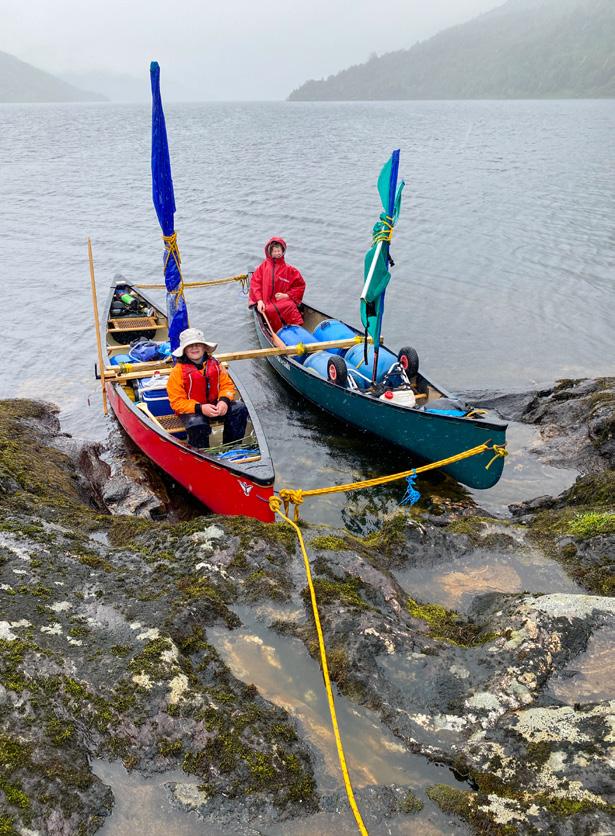
problem’. After all, I was on holiday!
We emptied the van and got the boats to the water. Ptarmigan and Lutra enjoyed rolling the barrels down the ramp to the canoes (almost losing one into the water!). Then distractions by the water took hold of the kids, which gave me the faff time to organise everything. A couple of locals explained where to park so as not to be in the way. They ran cruises on the loch and kindly took a photo of us, as well as passing me their number should I need it. I think they thought I was a little mad when they realised it was just me and the two kids!
Sailing from the get-go with just one sail up we made good time with little effort. Lutra stating “We are cutting through the water like a knife.” We spotted a black throated diver and were able to look at the gorgeous bird through our binoculars.
Half-an-hour later, both kids said they were hungry. We pulled over a couple of k’s from the start. After landing we waved to some other paddlers who passed us by. The kids seemed excited to see others and eagerly explained what our plan was, shouting it across the water.
“The midges are out,” I explained to the kids, putting my midge net on, and suggesting the kids put their gloves on as well as their nets. Head nets were put on but soon removed as they both found
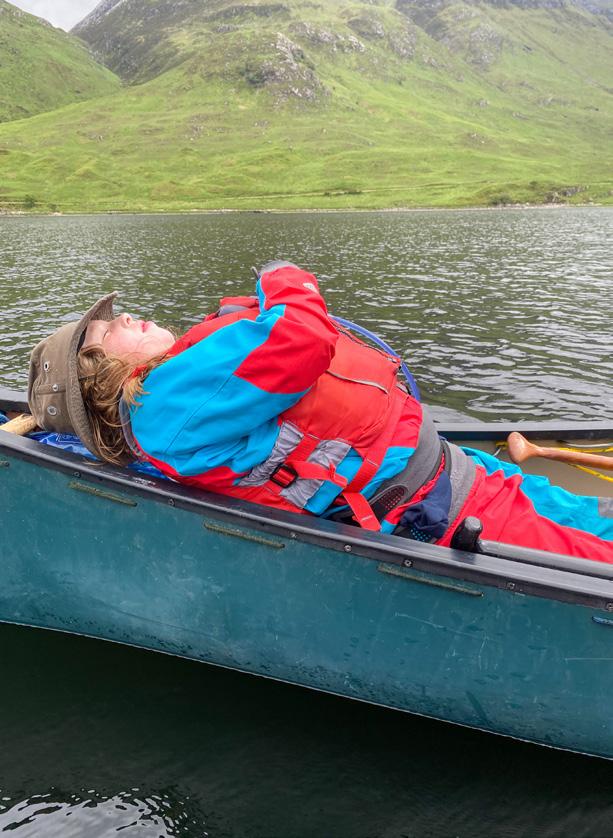
them obstructive. They didn’t know how bad the bites can itch after a day or so! I tried to explain but the conversation finished in a dead end. Some lessons I think you must learn for yourself! It was at this point I asked myself what my aims of the trip were. Yes, I had plans for good distance and great wildlife views each day but really, I just wanted a wilderness expedition that my kids and I could share. Sowing the seeds for many more. This realisation helped me massively throughout the trip.
The kids started to nap as we sailed along, so regardless of only paddling 6km we pulled over for the night in high but sleepy spirits. Ptarmigan and Lutra choose a great campsite with a flat pebbly area for two tents. We set camp together, Ptarmigan then lit a small fire that we cooked on, and I had the pooing and weeing chat with them and explained how the Personal Locator Beacon worked and when to use it. I had good phone signal too! It started to drizzle and with a little encouragement Dryrobes were put on and we sat by the fire. The kids soon realised the connection between the smoke from the fire and the lack of midges. They occupied their evening lighting sticks and using them as some magical joss stick midge defence. An early night was had by all.
“IT WAS AT THIS POINT I ASKED MYSELF WHAT MY AIMS OF THE TRIP WERE. YES, I HAD PLANS FOR GOOD DISTANCE AND GREAT WILDLIFE VIEWS EACH DAY BUT REALLY, I JUST WANTED A WILDERNESS EXPEDITION THAT MY KIDS AND I COULD SHARE.”



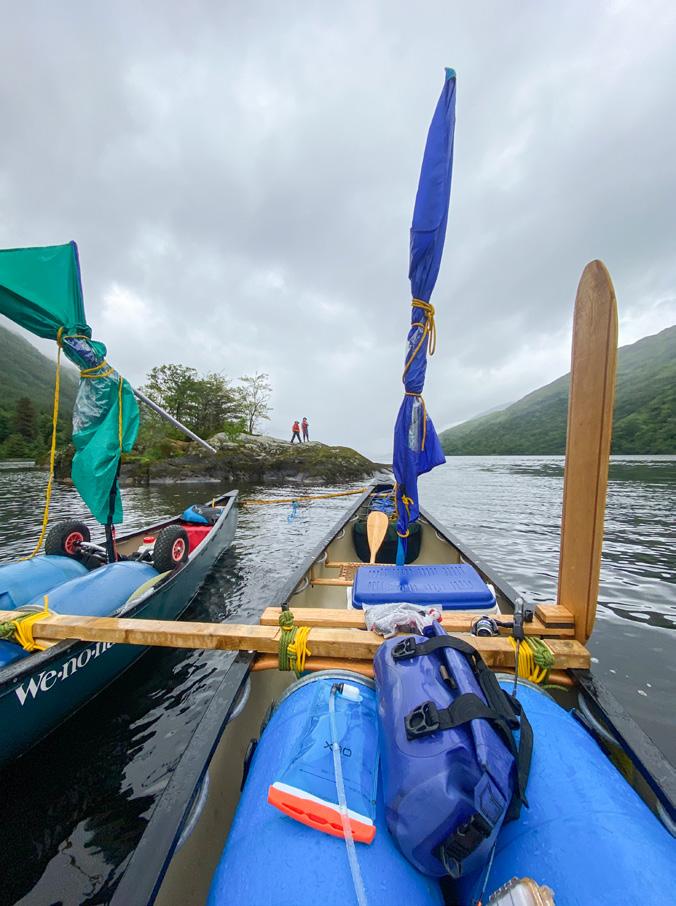
We packed down and both kids did a good job of packing their stuff away. But I now know that it is very difficult to stuff a sleeping bag in a stuff sac (and even harder to roll up a blown-up sleeping mat) so it fits in its bag, when you’re only 10 and 8 years old. After a quick cereal breakfast we set off and, as we watched a common sandpiper on the shore, we discussed the cuckoo calls, we’d surprisingly been hearing throughout the night.
Overnight the wind had changed so sails were kept down. We were making headway but I was soon trying to work out the best side of the loch to paddle. We headed across the lake, ferrying the wind as we paddled. I’m not going to lie, it was hard on us all. We made headway but about three-quarters of the way across both kids started to tire and my frustration bubbled a little. I offered the carrot of exploring an island we were aiming for, and that proved to be enough for the paddling to continue.
On the island I got some eggs and bacon out for our second breakfast and the kids had a look around the island. I got a map out and explained that it would be better if we crossed again. We discussed our next leg and Ptarmigan and Lutra agreed a point to aim for. Off we went but with warm food as fuel.
By the time we made our second crossing both Ptarmigan and Lutra needed a bit of out-of-boat time. We landed on a pebble beach that had a small
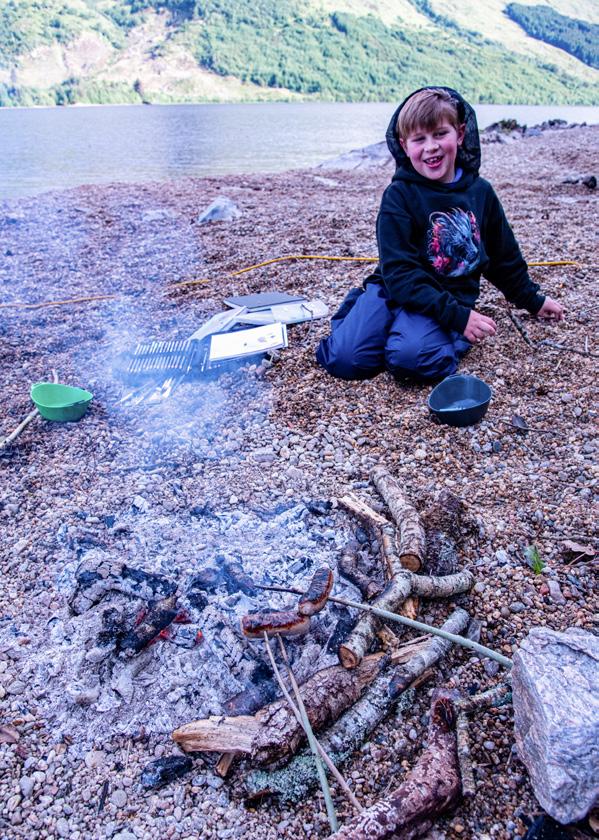
stream running down it which disappeared into the pebbles before reaching the loch. Ptarmigan asked to fish and Lutra set himself the goal of helping the stream reach the loch. I split my time between helping Ptarmigan learn to cast and building a series of dams that, once released, would help Lutra reach his goal. Then Ptarmigan and I explored the coast with camera in hand as Lutra played. We came across a sandpiper and then its tiny chick. We back-tracked straight away for obvious reasons that I explained to Ptarmigan, she would have claimed it as her new cuddly. At this point we set camp even though it was midafternoon. The kids were happy, so I was happy. Lutra lit a fire and the kids whittled sticks that we used to cook sausages on over the flames, with pasta and broccoli as side dishes. Once dusk showed itself, we played around with some lowlight photography and some light painting.
From my tent I realised the wind had picked up again! I got out of bed and immediately saw a golden eagle approaching in the distance. “Eagle!” I shouted. The kids where quick enough to watch it soaring over our heads.
Getting on the water with both sails up we flew down the loch, scanning for eagles the whole time. We were getting closer to where I’d seen


white tailed eagles on previous trips, and this was one of the wildlife encounters the kids wanted. I wanted to land on Eilean Fhianain to explore the chapel ruins. After exploring the island and reading about the history of the chapel we bumped into some fellow paddlers. After a ‘quick chat’ and photo we were off again.
The wind was top end force 4 now and one of the poles slipped out of its foot. After a quick fix and a bit of voiced reassurance to the kids off we went again.
Still scanning for eagles whilst eating oranges I spotted an upright log near the shore. The binos came out. “Eagle! It’s a white tailed eagle.” We all had a look and decided to see if we could get closer. The eagle flew off just as we approached the shore but landed in a tree plantation not far off. Camera and binos in hand we stalked closer, getting about 50m away. We settled to watch.
The eagle flew and we excitedly chatted whilst searching for a feather. “Majestic,” is how Ptarmigan described the eagle. Just as we were getting into the boats Lutra pointed upwards and said, “is that their mate?” Looking up I saw an osprey flying above our heads.
It was getting late, however, due to houses on the shore camping wasn’t an option. We sailed on, covering the last 2km to the river and then looked for a secluded camp. We had one false
“AT THIS POINT WE SET CAMP EVEN THOUGH IT WAS MID-AFTERNOON. THE KIDS WERE HAPPY, SO I WAS HAPPY. LUTRA LIT A FIRE AND THE KIDS WHITTLED STICKS THAT WE USED TO COOK SAUSAGES ON OVER THE FLAMES, WITH PASTA AND BROCCOLI AS SIDE DISHES.”
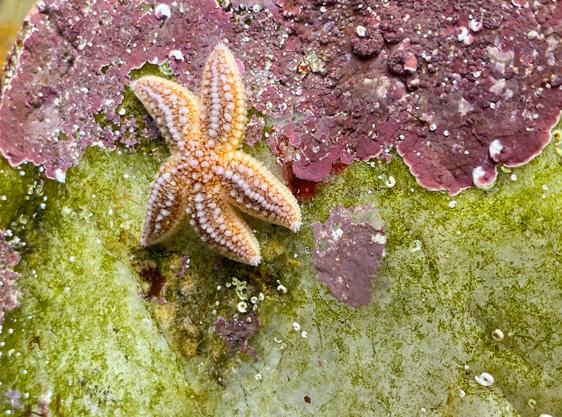
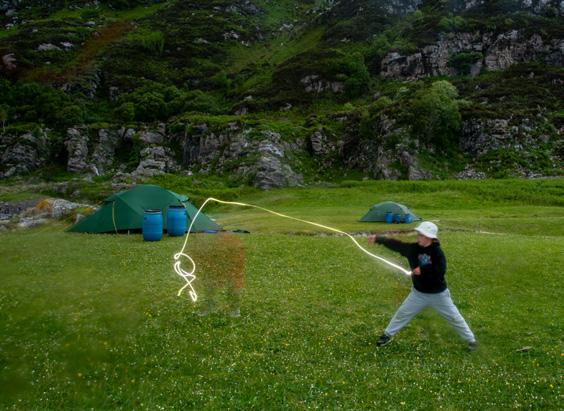
“‘WEE BEASTIES’ IS HOW I’D DESCRIBE THIS CAMP. ALL HEAD NETS WERE ON! THE KIDS HANDLED IT WELL BUT THERE WAS NO ESCAPE UNTIL THE TENTS WERE UP. THE KIDS HID AND THEN ATE INSIDE THE TENT. I SUFFERED BUT HAVE SOME RESILIENCE. I USED IT ALL!”
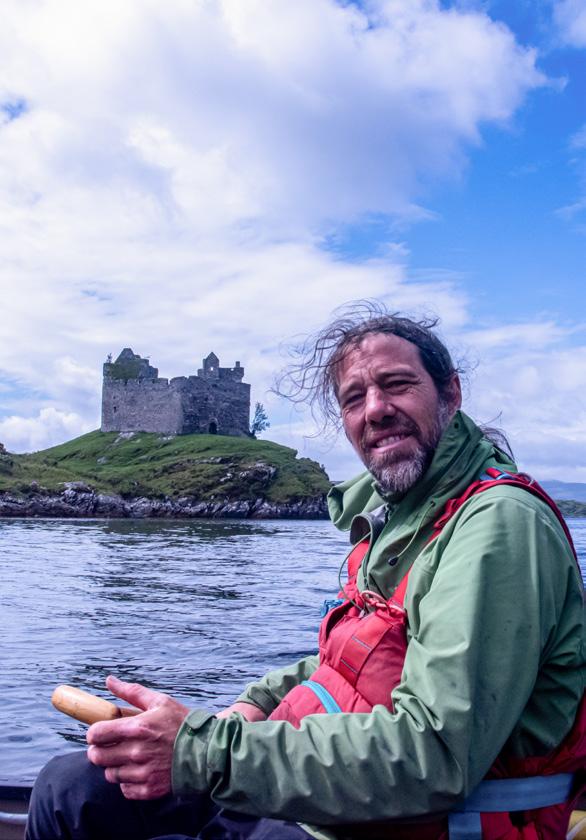
start due to boggy ground but struck gold a short way down. ‘Wee beasties’ is how I’d describe this camp. All head nets were on! The kids handled it well but there was no escape until the tents were up. The kids hid and then ate inside the tent. I suffered but have some resilience. I used it all!
The following morning it was the same. I got everything sorted while the kids hid and then they just kept walking whilst I sorted their tent. Relief washed over us as we left them behind. Tide times were known so we cruised into Loch Moidart, heading to Castle Tioram for second breakfast.
We met some fellow North Wales residents. I chatted, cooked and ate whilst the kids played hide and seek before joining in for the eating.
We headed to the north channel and received a funnelling wind in our face. We battled on, knowing that the channel dries during low tide. That had to be explained to the kids! We windeddied our way up, stopping five times over the 6km to our camp. Great sightings of moon jellyfish and the knowledge of a mid-afternoon camp with no midges kept our minds positive.
The campsite was blissful. The kids rock pooled whilst I set camp. Hermit crabs, crabs, two starfish, fish, shrimps and (surprisingly) newts were spotted and/or collected and then released. An unfortunate
dead tern was found then buried with a bit of sand. A group from Outward Bound joined us in the evening. We all got along and the free childcare in the shape of the group was awesome. An evening fire, Ptarmigan’s first successful wild poo attempt and a lovely sunset over the Small Isles added to our evening’s entertainment.
The following morning looking out I realised we were stuck. The wind was blowing from the northwest force 4 and we were on the headland with no shelter. Why move? The wind was less tomorrow, especially early doors, so a rest day it was!
We watched fishing terns, gannets, shags, cormorants, red breasted merganser, and a great norther diver. We ate a lot, had our feet nibbled by newt tadpoles, the kids rock pooled, spotted another white-tailed eagle, had a driftwood fire and a little more low-light photography, before settling in for the night and both had successful wild poos.
I was up at 5. I could hear the lack of wind and I wanted to go. I sorted the inside of my tent, everything packed away, unzipped and got out stretching. As I did so I automatically looked out to sea. A pod of bottle nose dolphins was just
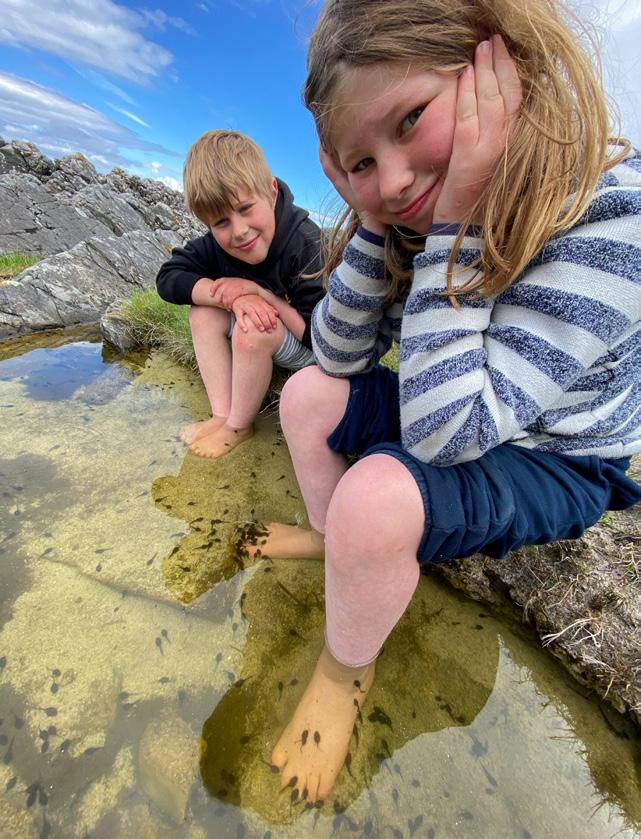
offshore. “Dolphins,” I called. The kids were out like a shot.
We watched the dolphins whilst walking closer to get a better view. After a few minutes Lutra’s tiredness took hold and he sloped of to his tent. Ptarmigan and I drew the conclusion that the pod where fishing using the rocks to help corral the unseen fish. Just then I couldn’t believe my eyes. An otter! I waited for it to dive before running back to get Lutra so as not to scare it. If you haven’t Googled it yet, it’s his namesake. Lutra and I got back in time to watch it for a couple of minutes before it dived and wasn’t seen again.
Ecstatically we took the tent down and set off with the wind building against us. We battled upwind and had to tack with sails and the leeboard down to make headway for the first 45 mins, before turning with the wind heading into the Sound of Arisaig with Loch Ailort ahead. I passed the steering mantle to Ptarmigan as I turned my thoughts to the remainder of our trip. It was Friday. The clutch suddenly niggled on my mind. It was still early, and a lovely landing was not far, even if the tide was currently a fair way out. I mentioned my thoughts to Ptarmigan and Lutra and we all agreed that we had completed our first wilderness canoe trip!
I used a trolley to move the boats up the beach whilst watching a pair of ringed plovers. A short
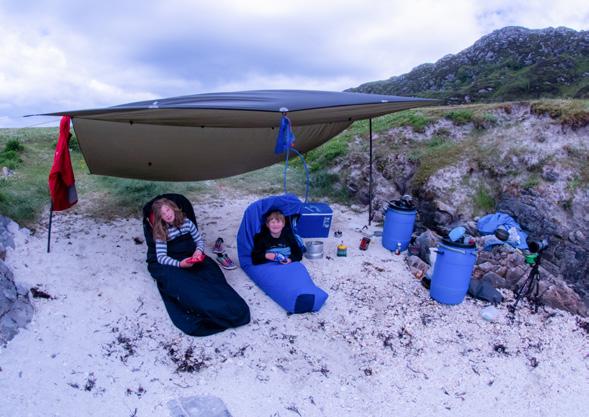

walk into Glenuig and then we waited with thumbs out for a lift back to our van. Only five cars passed before getting a lovely chatty lift. They took us all the way to the van. Incredibly I manged to limp the van to Fort William before phoning the friend I phone in these circumstances. Under guidance I topped up the clutch fluid, bled the pipes and miraculously set off home. Travel home was full of chats, and the realisation that the lucky socks had worked again! We have lucky socks that seem to help us spot wildlife.
All I can say is, “there’s nothing - absolutely nothing – half so much worth doing as simply messing about in boats.” (Kenneth Grahame, Wind in the Willows)

“I SORTED THE INSIDE OF MY TENT, EVERYTHING PACKED AWAY, UNZIPPED AND GOT OUT STRETCHING. AS I DID SO I AUTOMATICALLY LOOKED OUT TO SEA. A POD OF BOTTLE NOSE DOLPHINS WAS JUST OFFSHORE. “DOLPHINS,” I CALLED. THE KIDS WERE OUT LIKE A SHOT.”
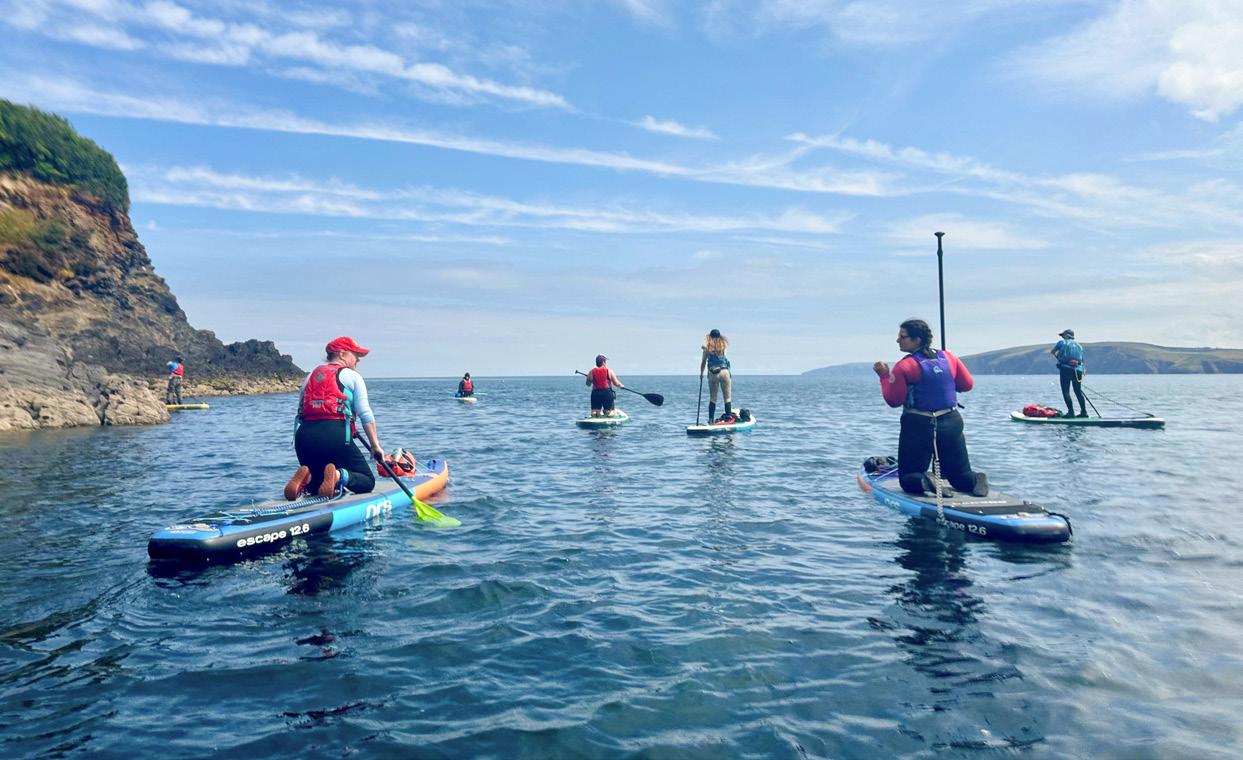
The #ShePaddles Cymru Summer Celebration Festival brought together women and girls from across the UK of all ages and backgrounds for a memorable weekend of paddling, skill development, friendship-making, and celebration. Hosted at the perfect Llandysul Paddlers, the event highlighted the growth and success of the #ShePaddles Cymru initiative.
In attendance were 60 participants and around 20 female volunteers and coaches. Of course, there were also some amazing supportive male instructors and staff that are fantastic at motivating the participants.
There were lots of workshops on offer including whitewater kayak confidence building, whitewater canoe sessions, and sessions being run by GB Freestyle and GB Rafting.
“Huge thanks to all who make this weekend happen. It’s great to see women growing and gaining confidence in their sport. Everyone is catered for according to their ability, which is a feat in itself. Was lovely to meet so many awesome women and supportive men.”
The weekend started as fun filled as it was set to continue. It was fantastic to see the lake and river full of excited participants having a chilled-out paddle. The evening continued with an inspirational talk from Tavi Murray about her circumnavigation of Wales, which she had only completed a couple of weeks before. The evening was finished off with a fun get-to-know-you bingo where we saw people's competitive side really shine. It’s amazing what people will do for a pair of the legendary #ShePaddles Cymru sunglasses.
ARTICLE : LYDIA WILFORD, CW DEVELOPMENT OFFICER
After a delicious breakfast, it was time to get on the water. There were workshops for all levels of ability, from beginner to advanced paddlers, including SUP yoga and SUP racing, GB Rafting, and GB Freestyle workshops. There really was something for everyone.
Over lunchtime there was a chance to listen to Rachel Bott talking about the exciting wildlife on the Pembrokeshire coast. Then it was back on the water again for the afternoon workshops. The competitive spirit came out in a fun slalom. The atmosphere was electric, and everyone was having a fantastic time which led us into the evening of another brilliant talk from Katie Simmons, the first Brit to paddleboard the Grand Canyon. We were so lucky to have such fantastic talks from amazing inspirational women.
We then had a chance to learn about and try some local gin, rum and cheese which got everyone in the mood for the evening disco.
With some tired eyes, everyone was still full of spirit and ready to head off on day adventures. Activities included sea kayaking, whitewater river trip, coasteering, and a more chilled flat-water trip. When everyone returned there was lots of chatter about the exciting days that had been had and then the sadness hit that it was over for another year and it was time to go home.
This was the most fantastic event with incredible participants, brilliant workshops and activities, and lots of laughter and joy. Life-long friendships have been made along with some incredible memories.
These events would not happen without the support of all the fantastic #ShePaddles Cymru volunteers, supporters that offer prizes, Canoe Wales, and let's not forget all the super hard-working staff at Llandysul Paddlers with a special thank you to Gareth and Alix
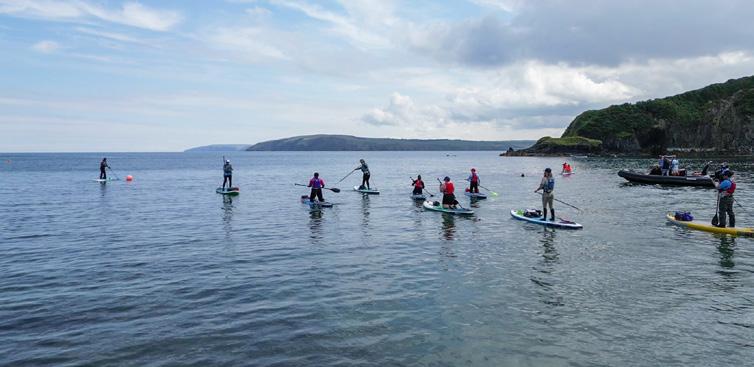


This event is so important as it helps to build a community of female paddlers. It allows the participants to connect with likeminded individuals, share stories, and forge new friendships. I feel very lucky to be surrounded by such awesome women and girls who are so inspiring and supportive of each other.
“Loved this weekend! Thank you so much to everyone involved in making this possible! I know you all worked soooooo hard to put this together and create such an incredible atmosphere for women to thrive and love paddling! These events are about sooo much more than the epic program of activities and coaching we have all had the joy of gaining so much from! The atmosphere and friendships they create are something I’ve never experienced anywhere else! Each time I go to an SPC event I have the deep-seated feeling of “these are my people, this is my tribe!” A group where you know no matter what your worries or your passions the women you just met on the other side of the table totally get it!! Where you can see beginners thrive in fantastic sports and be inspired by those in the know who come and share their experiences.”


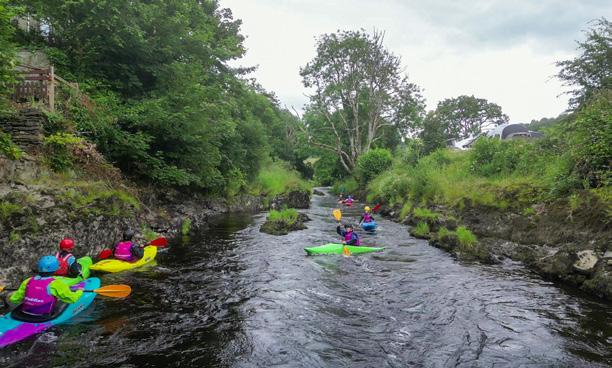


ARTICLE: CAROLINE DAWSON
The Amazon is a unique place, a vast and mostly uncharted region spanning an area twice the size of India. It is teeming with adventure and mystery, and hosts some of the most fascinating cultures and wildlife on Earth. However, it faces significant threats such as deforestation, narcotrafficking, illegal mining and wildlife poaching, with nearly 20% of the rainforest having been lost over the last 50 years.
The Amazon Challenge is a unique paddle challenge for both canoes and SUP’s. It involves navigating 335km of the Madre de Dios River, one of the main tributaries of the mighty Amazon that rises in the Andes. The challenge is a fully self-sufficient journey carrying all your own gear, including camping kit, dehydrated food and water. Paddling swift currents and multiple rapids up to grade 3, whilst dealing with high humidity, temperatures +30C, no stop zones, uncontacted tribes, illegal gold mining, cocaine production and wildlife.
Before heading into the water, all teams were required to complete essential safety training on the river. This training included demonstrating self-rescue techniques and flipping a fully loaded board, carrying approximately 25-30kg of equipment packed into our waterproof Mustang bags.
Following this a navigation session was conducted, providing each team member with a Garmin Inreach to load GPX files, and a full set of 40-year-old paper maps. The river section we were navigating was extremely isolated and forever changing. Soon after starting our journey, we discovered that neither the paper nor electronic maps provided much useful information. We simply had to go with the flow and utilise our skills and knowledge.
Total distance: 335 KM
Paddle strokes: 58,322
Calories: 18,000+
Average speed: 8.3 km/hr
Total time paddling: 40:24.08
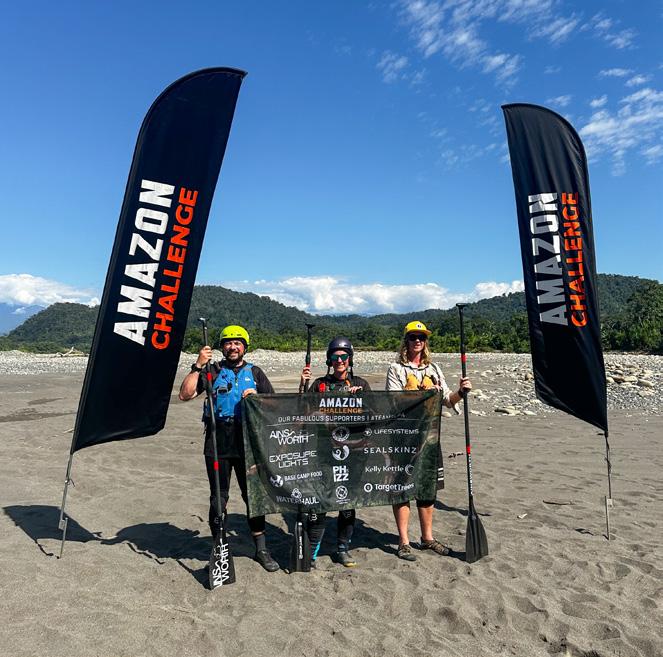


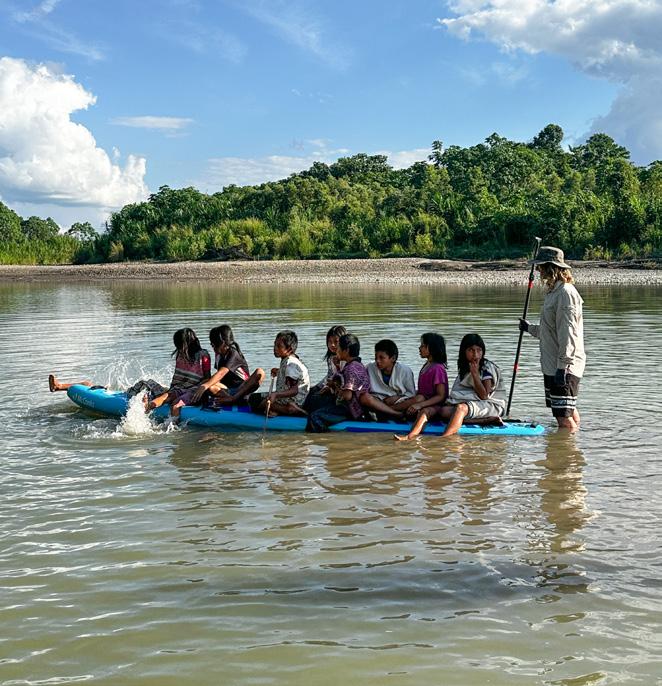

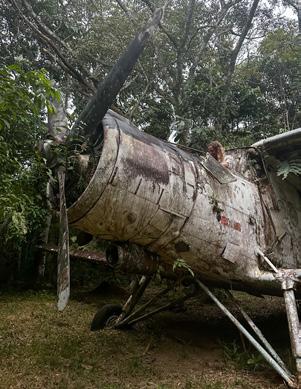
“DESPITE BEING THE SHORTEST STAGE OF THE AMAZON CHALLENGE, IT WAS FILLED WITH EXCITEMENT; FEATURING SOME OF THE LARGEST BOILS AND WHIRLPOOLS WE HAD EVER ENCOUNTERED AS PADDLERS.”



RAPIDS, RESCUES AND BIG CAT PAWPRINTS
The challenging stage began with a swift and sizable volume of water! Paddlers faced a demanding test dealing with numerous G2/3 rapids and tricky eddy lines. Matt impressed everyone with his adept rescue skills, aiding fellow paddlers.
For lunch, a meal of chicken, rice and a hardboiled egg wrapped in a banana leaf was savoured on a sandy riverbank adorned with jaguar paw prints. This peaceful break was interrupted by the arrival of pesky sandflies ... a constant pest on our whole journey down river.
Our journey commenced from Pillcopata to Shintuya, the land of the Harakmbut people. Here, we refreshed ourselves in waterfalls, listened to stories from village elders, and even got our first jagua fruit tattoos by the campfire.
BOILS, SMILES
The day began with a Real Turmat breakfast sat in a jungle hot spring while we appreciated our new jagua tattoos.
Despite being the shortest stage of the Amazon Challenge, it was filled with excitement; featuring some of the largest boils and whirlpools we had ever encountered as paddlers. The



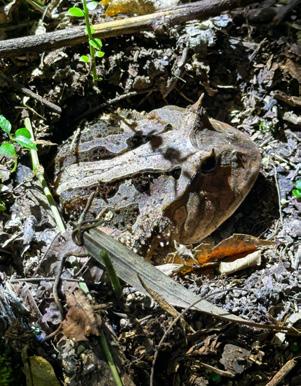
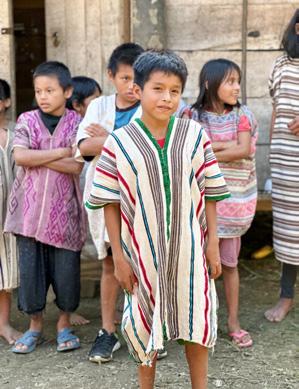
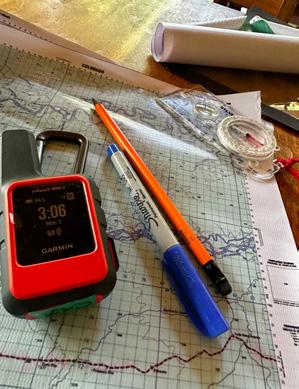
reason for the shorter day was to maximise our interaction with the Shipetiari community. They wanted to treat us to masato, a traditional Peruvian drink made by boiling, peeling and fermenting yuca. We were warmly welcomed in their village banana plantation and spent quality time playing with the children – did you know that 11 kids can fit on a 14’ McConks board?
Everyone felt a bit anxious at this point as we travelled through the land of the uncontacted Mascho Piro tribe – make sure to research them! We had to paddle through almost 40km of continuous zones, with strict instructions to stick to the 'river right' side.
After navigating the non-stop zone, we entered what seemed like a forest graveyard, where the Madre de Dios river deposited massive amounts of tree debris, some over 50m long. We had to stay alert as the strong currents and debris posed challenges for the canoe teams.
We took a quick break at Boca Manu for a required medical check (to look for things such as foot rot - which the socks from Sealskinz certainly helped with), a refreshing beer and to grab some super sweet orange chomps, which had become a team favourite snack!

Resuming our journey down the river we reached our forest camp for the night. Setting up our tents we later discovered we had camped less than 10m away from a nest of tarantulas. Caz spotted them during her daily ‘trowel’ walk. That evening Brodie, a passionate photographer working with the Manu Biological Station for the past year, led us on a night-time forest walk where we got to use the red light on our waterproof Exposure Lights head torches. He shared a wealth of knowledge about horned frogs, wandering spiders, false coral snakes and more!
GIANT
From this point on the river's flow decreased while the meanders' length increased. The temperatures remained above 30C, with high humidity making it challenging to stay cool. To cope we wore the UV tops from Mustang Survival, factor 50 sun cream from Lifesystems and our Waterhaul sunglasses daily. Every day we consumed our full allowance of 6 litres of water from our boards and more at camp, making sure we replaced essential salts through taking our Phizz tablets. Water became an issue due to pollution from gold mining operations affecting the river, so we had to rely on refills from the local support crew.
“WE WERE WARMLY WELCOMED IN THEIR VILLAGE BANANA PLANTATION AND SPENT QUALITY TIME PLAYING WITH THE CHILDREN –DID YOU KNOW THAT 11 KIDS CAN FIT ON A 14’ MCCONKS BOARD?”

“ON THE LAST DAY OF OUR ADVENTURE WE ENCOUNTERED OUR SOLE MEDICAL EMERGENCY WHILE NAVIGATING THE RIVER. A SWARM OF LARGE AMAZONIAN WASPS STARTED CHASING US AND, UNFORTUNATELY, MATT GOT STUNG ON THE HAND.”

On day 4 we had an unforgettable wildlife encounter; observing endangered giant otters playing in a nearby back channel. Navigating the river involved choosing the right channels, as some areas split into multiple branches, including cocaine laboratories emitting a distinctive silagesweet odour as we paddled past.
The biggest and longest paddling day – 9 hours on treacle like water, which had by now turned orange due to mining activity. Today the scenery changed quite a bit – it felt like we had left the untouched rainforest and entered an area that was on the frontline with man. The forest looked thinner, diesel engines chugged and piles of waste stone heaps grew in size. We were now in the heart of gold country and nearing the wild west town of Bocu Colarado. A real hotbed of gold, poker and hookers! A place we left as quickly as we arrived to try and make the 5pm check point cut off – we were the only team to make it on time, with 30 seconds to spare!
As the sun began to set we watched as macaws returned to their roosts – a truly magical sight!! One of the most memorable sunsets of the trip.
On the last day of our adventure we encountered our sole medical emergency while navigating the river. A swarm of large Amazonian wasps started chasing us and, unfortunately, Matt got stung on the hand. We were just under 10km from completing the challenge. Caz swiftly opened her Lifesystems first aid kit and administered antihistamine, possibly giving him a bit more than needed for safety. We alerted the safety team since we were uncertain about the seriousness of wasp stings in the rainforest. Despite the ordeal, Matt persevered!
With one final effort around the largest bend of the journey we spotted the finish line. Celebratory beers and wide smiles awaited us at the finish. It was a remarkable accomplishment for us all, especially for Caz who, only a few weeks after emergency gallbladder surgery, became the first woman to paddle this section of the Madre de Dios River on a stand-up paddleboard.
OUR FUNDRAISING
As a team, we raised almost £2500, which will be split between the indigenous communities and the biological stations we visited.



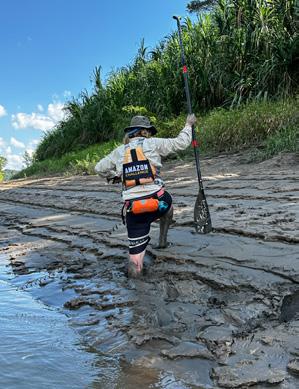
CAROLINE DAWSON
Owner of award-winning adventure business,
SUP Lass Paddle Adventures based in North Wales, Caz is an accomplished paddler and coach who has successfully completed several long-distance SUP races and challenges. Her recent overseas trips include paddling the Vjosa in Albania and guiding trips for SUP Norway and SUP Driven in Scandinavia.
JONATHAN GILL
An experienced river paddler and partner to Caroline, Jon has previously taken part in a number of team paddle challenges. He is a keen adventure photographer and professional drone pilot. Jon was responsible for capturing and documenting our journey down the Amazon.
MATTHEW PHILLIPS
A seasoned paddle boarder and natural leader, who is currently guiding river expeditions in the tropical north of New Zealand. Matt has also spent several seasons guiding SUP adventures in the Panamanian jungle, exploring unmapped areas. Matt will be our jungle critter expert.

We would like to thank the following businesses for their support: McConks – 14’ boards
Mustang Survival – PFD, bags and clothing
Ainsworth Paddles – paddles
Lifesystems – first aid kit, sunscreen
Base Camp Food – meals
Kelly Kettle – water purification
Exposure Lights – waterproof head torches
Sealskinz – socks
Waterhaul – sunglasses
Phizz – hydration tablets
Target Trees – cash
Agronomic Digital Innovation – cash
Fancy giving it a go in 2025? Learn more at www.amazoncanoechallenge. com or follow them on social media: Instagram: @amazoncanoechallenge | Facebook: Amazon Canoe Challenge
ABOUT SUP Lass Paddle Adventures are based in North Wales and are providers of SUP adventures and experiences.
Instagram: @sup_lass
Facebook: SUP Lass Paddle Adventures
“WITH ONE FINAL EFFORT AROUND THE LARGEST BEND OF THE JOURNEY WE SPOTTED THE FINISH LINE. CELEBRATORY BEERS AND WIDE SMILES AWAITED US AT THE FINISH. IT WAS A REMARKABLE ACCOMPLISHMENT FOR US ALL.”
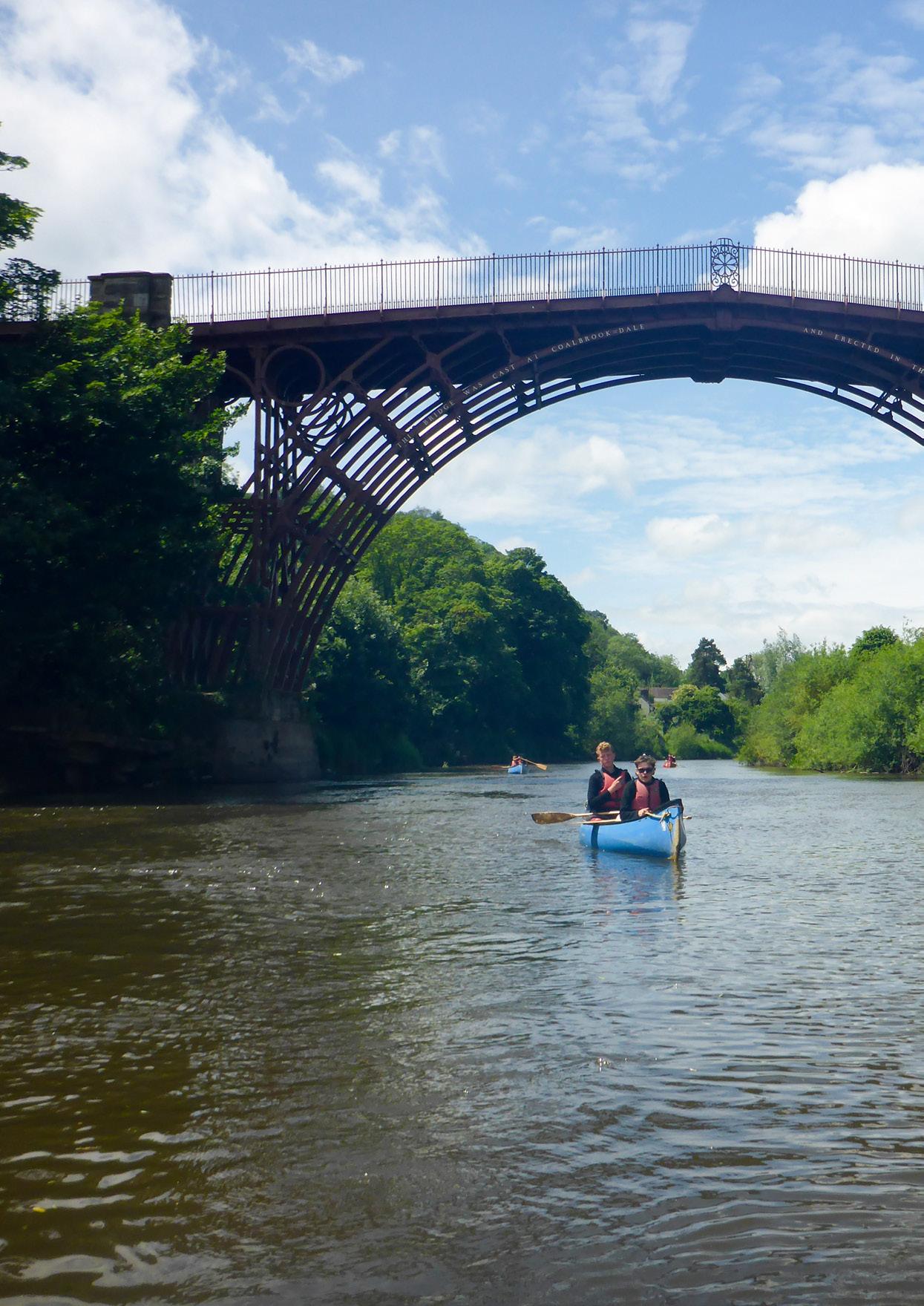


Ever year as part of the outdoor education curriculum here at St. David’s College, Llandudno, Year 10 pupils undertake an expedition in an activity of their choice – usually choosing between mountaineering, trekking, caving, climbing and my (perhaps a little biased) favourites, canoeing and sea kayaking. The groups undertake training and help with planning as part of their school lessons, before heading out on a week-long expedition.
This year the canoe group’s objective was to paddle from the upper reaches of the historical navigation on the River Severn, from Pool Quay to Coalport just downstream of the Jackfield Rapids. A journey of about 96km on the river, although much shorter in a straight line!
It quickly became apparent on day 1 that nobody had passed through or used Pool Quay as a launch point in some time … the folding saw came out and stayed out as we battled through logjams and willow strainers, and it was a longer day than anticipated down to our camp at Llandrinio.
WORDS : ALED EDWARDS
PHOTOS: AS CREDITED
Following the confluence with the Vyrnwy on day 2 the river widened, the saw could be put away and the group were able to look around a little more rather than watching out for the next killer tree. Red kites soared above the surrounding fields and sand martins played around our heads. Day 2 was a much better day. It was a long day though, with 26km of slow water eventually bringing us to ‘The Isle’, the first of our wild camps, although it did have a composting toilet which the group treated with some suspicion! A steep bank, typical of many of the access points to the river, meant some pot washing clinging to a wooden ladder secured to a muddy bank … which must have been very funny to watch.


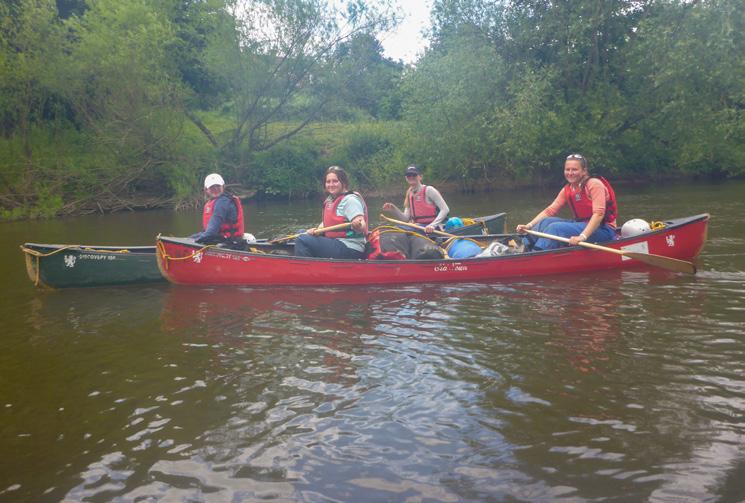
We were treated to some urban scenes on day 3 as we passed through Shrewsbury, complete with a portage around Shrewsbury Weir (although the café here made it worthwhile). Portage done, it was down to Atcham for our last wild camp, although after their experience with the composting toilet most of the group managed to find their way to the posh toilets in a nearby hotel rather than find a bush.
The last day of paddling took us through the famous Ironbridge Gorge and under the iconic bridge itself. A last exciting blast was provided by the Jackfield Rapids, where some found a more aquatic line than others as they smashed through the bottom wave.
The sea kayak group opted to head north and, after hearing about the wildlife encounters and views experienced by last year’s group on Skye, decided on an attempted rounding of Ardnamurchan Point to find some basking sharks. Sadly the weather had other plans, faced with a week of force 5-6 winds (all while the rest of the UK seemed to be enjoying light winds and sunshine) plans had to be adjusted.
It was decided to explore the coastline around the islands of Oronsay and Carna, at the mouth of Loch Sunart. Despite the weather we were able
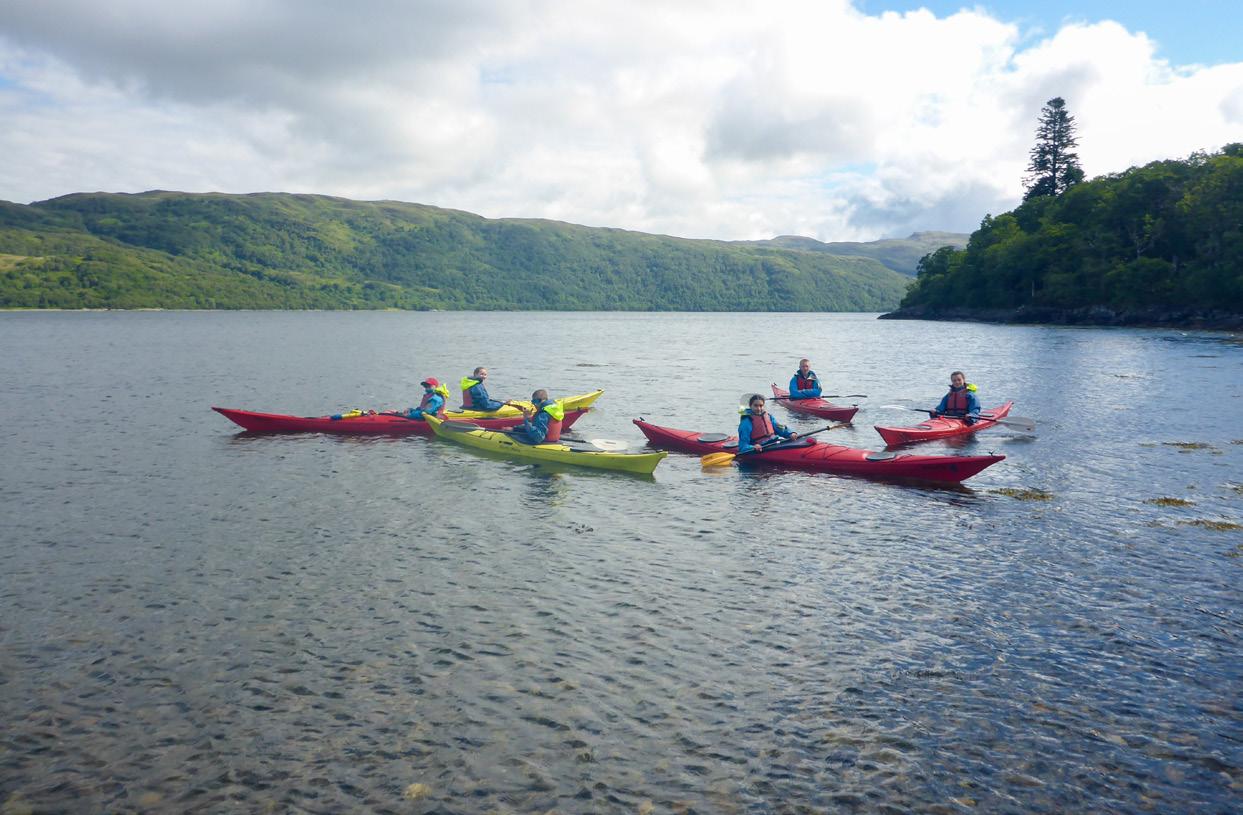
to enjoy 3 wild camps, and 4 days of kayaking in the area, spotting seals, giant starfish, eagles and porpoise along the way. Thankfully the plus side of the windy conditions meant no midges! The group got off the water on the last day having paddling through some fairly interesting conditions, and just in time for the wind to pick up even further. We had got up especially early to avoid paddling in this stronger wind and it was a good demonstration in working with the ocean, as opposed to fighting it.
Hopefully both groups will remember the positives from the trip and have memories to last a lifetime. Who knows … perhaps they will get out again on their own paddling adventures in the future. Well done everyone!
ABOUTAled is a teacher in the outdoor education department at St. David’s College, Llandudno. Outdoor learning is central to the ethos of the school, and many adventures are had as part of the pupils' education. To find out more about these trips (or to find out more about the outdoor education curriculum at the school) feel free to send him a message at aedwards@stdavidscollege.co.uk or visit www. stdavidscollege.co.uk.
